IBPOC TAKEOVER EDITION
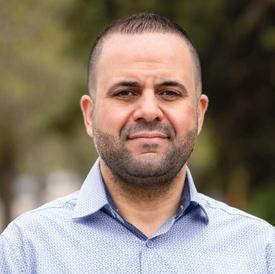

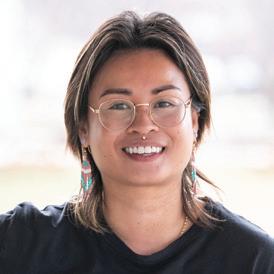
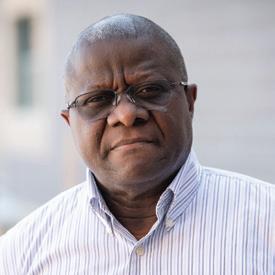
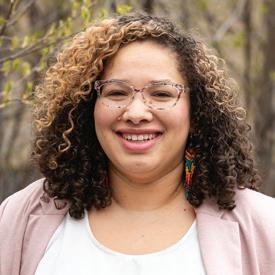

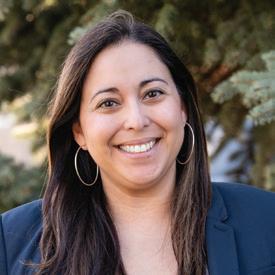

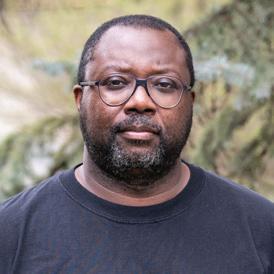
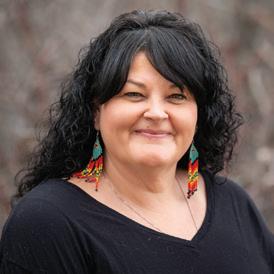

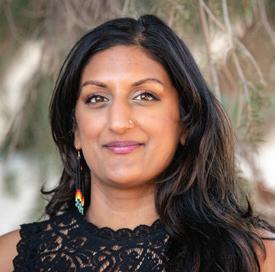
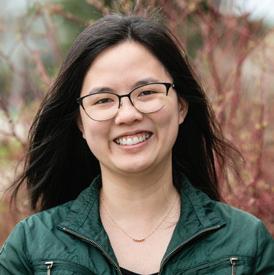


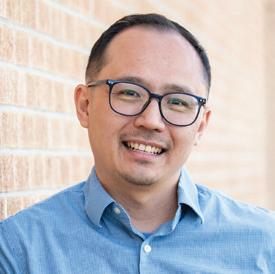
SPRING 2024 | VOLUME 102 NUMBER 3
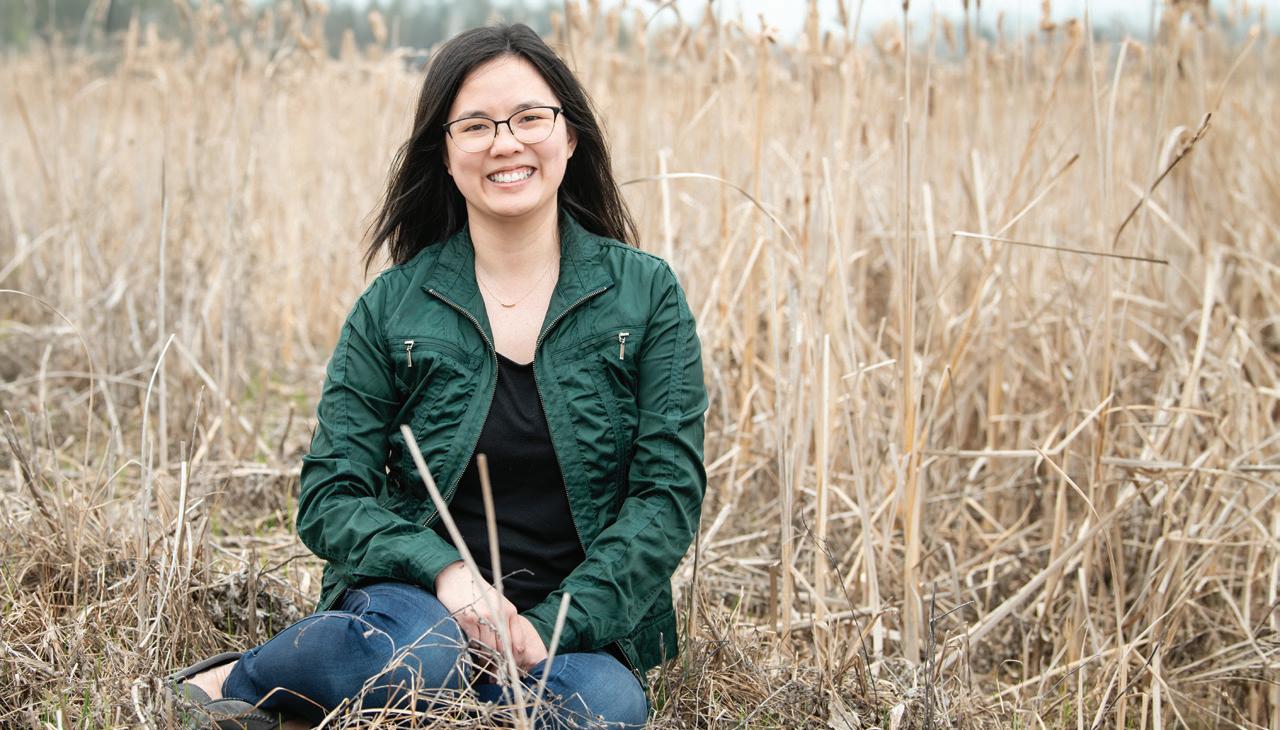
into the transformative potential of counter storytelling in science education with Peiki Loay, challenging dominant cultural narratives, and mobilizing marginalized voices in the science classroom. Uncover strategies for incorporating diverse perspectives and fostering inclusivity in science education. Join us on the journey towards a more socially just and equitable world.
CONTENTS SPRING 2024 | VOLUME 102 NUMBER 3 Dive
14 COVER STORY COUNTER STORYTELLING IN SCIENCE EDUCATION 14 8 AHLAN WA SAHLAN: WELCOME 20 TURNING THE PAGE: TRANSFORMING LIVES AND LIBRARIES 30 THE JOURNEY STRUGGLE TO UNION LEADERSHIP 34 UNE RÉFLEXION SUR L’IMPORTANCE DE LA REPRÉSENTATION 36 HONOURING INDIGENOUS VALUES FOR TRUE RECONCILIATION FROM THE GUEST EDITOR 6 FROM THE VICE PRESIDENT 7 EMBRACING MULTIRACIAL IDENTITY INVISIBLE MINORITY 11 18 IDENTITY: SO MUCH MORE THAN “WHERE I AM FROM” BRIDGING EDUCATION AND DANCE ILLUMINATING DIWALI DISRUPTING BUSINESS AS USUAL BREAKING THE ICE 22 26 27 28 40
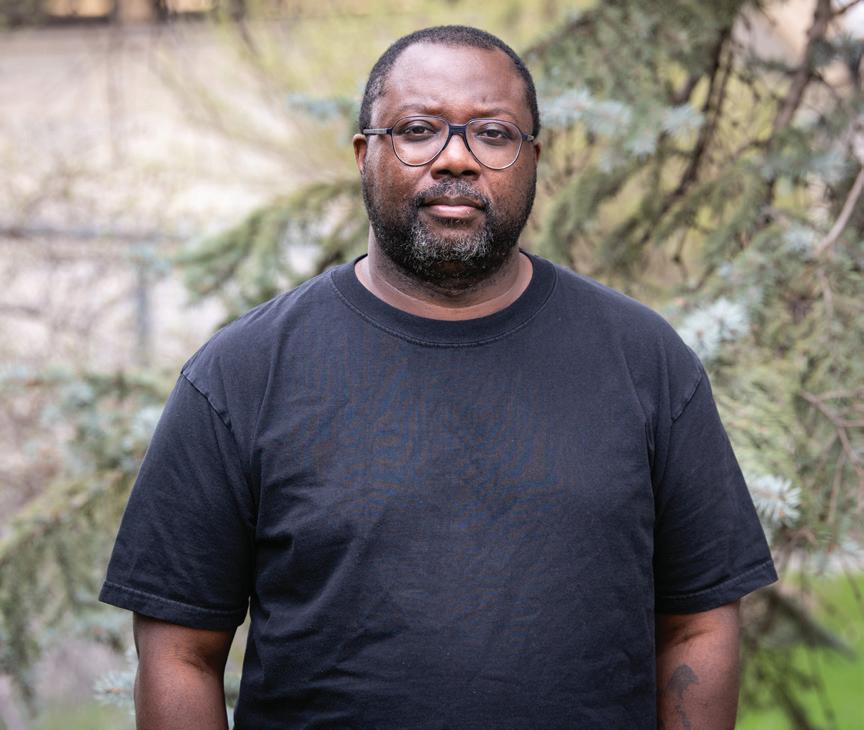


Clifford Weekes shares his insightful exploration of navigating selfdoubt as a racialized educator. From questioning legitimacy to finding strength in community, Weekes candidly shares his journey, reminding us that in the pursuit of understanding and acceptance, support and solidarity are essential.
Embark on a journey of rediscovery and healing alongside Alison Lubinski. As a proud Métis woman, Lubinski shares her personal narrative, navigating the intricate layers of identity, trauma, and reconciliation. Join her in embracing identity, fostering inclusivity, and cultivating respect within the realm of education.
With poignant personal experiences, Maneesha Manuel highlights systemic issues within the K-12 public education system, passionately advocating for diverse representation in leadership to help combat racism. She issues a rallying call for change, advocating for equity in education to ensure a better future for all students.
12 24 38 THE PATH CONTINUES BEYOND SELF-DOUBT FINDING OUR WAY BACK THROUGH A LIVED CURRICULUM RACIALIZED AND TOKENIZED: THE MINORITY REPORT 12 24 38 BOOK REVIEWS PG.42
GUEST EDITOR
Allyson Fedak
ART DIRECTION AND DESIGN
Krista Rutledge
Matthew Kehler
PHOTOGRAPHY
Matea Tuhtar mtuhtar@mbteach.org
CIRCULATION
Jennifer Nasse jnasse@mbteach.org
ADVERTISING
Matea Tuhtar advertising@mbteach.org
SUBSCRIPTIONS
The MB Teacher is published three times a year by The Manitoba Teachers’ Society. Articles and views published herein do not necessarily represent the policies nor the views of the Society.
©2024 by The Manitoba Teachers’ Society. Unauthorized use or duplication without prior approval is strictly prohibited.
THE MANITOBA TEACHERS’ SOCIETY
191 Harcourt Street Winnipeg, Manitoba R3J 3H2
Phone: 204-888-7961 Fax : 204-831-0877
/manitobateachers /mbteachers
www.mbteach.org
PUBLICATIONS MAIL AGREEMENT
40063378 ISSN 002-228X
Return undeliverable Canadian addresses to Contact Services at The Manitoba Teachers’ Society.
CONTRIBUTORS
SPRING
2024
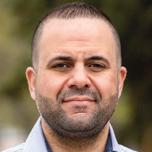
Izzeddin Hawamda
PAGE 8
Izzeddin Hawamda hails from a rural village near Nablus, West Bank. He is the new anti-racist education coordinator for several Winnipeg school divisions. A former high school teacher, he is also pursuing a PhD in Peace and Conflict Studies at the University of Manitoba.

Allyson Fedak
PAGE 11 | PAGE 22 | PAGE 26
Allyson (Ally) Fedak, a Grades 4-8 student support services teacher in her fifth year at École Lansdowne, has 13 years of experience. Dedicated to equity and social justice education, she serves on the Equity and Social Justice Committees for both MTS and the Winnipeg Teachers’ Association.
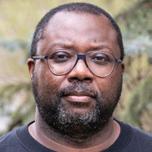
Clifford Weekes
PAGE 12
Clifford Weekes, in his second year as the anti-racism divisional teacher team leader for Seven Oaks School Division, has 14 years of experience. He taught Grades 1-5 for 12 years and now works with K-12 students and staff. Clifford is completing Post Bacc. studies at the University of Winnipeg.

Peiki Loay PAGE 14
Peiki Loay is a Grade 8 homeroom and science teacher in the Hanover School Division. She is passionate about science and math education, but also enjoys teaching ELA and art. Creating an inclusive culture is very important to her because of her experiences growing up as a second generation Canadian.

Kathy Simcoe
PAGE 18
Kathy Simcoe is an Anishinaabe woman, whose career in education has ranged from nursery school to adult continuing education, all in rural Manitoba. With a Master’s degree focused on land-based education, she takes every opportunity to share Indigenous perspectives in the Interlake School Division.

Pardeep Duggal
PAGE 20
Pardeep Duggal, a teacher-librarian at Collège Miles Macdonell Collegiate, has taught Grades 7-8 English, social studies, and worked in early years education. Since 2004, she has witnessed RETSD's growing diversity. Her passion for equity, inclusion, and diversity in schools has guided her career path.
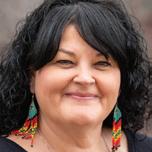
Alison Lubinski
PAGE 24
Alison Lubinski works in the Evergreen School Division as a teacher and Indigenous education consultant for Grades 9-12. She is also a sessional instructor at Brandon University delivering an online evening course around Truth and Reconciliation to graduate students.

Ripudaman Sidhu
PAGE 27
Ripudaman Sidhu is a kindergarten teacher in the Louis Riel School Division, and previously taught in Seven Oaks, Winnipeg, and India for 10 years. Passionate about helping others, she enjoys organizing and participating in cultural activities like Folklorama and Diwali festivals at her school.

Kim Cao
PAGE 28
Kim Cao (they/them) is a first-generation Vietnamese, non-binary educator. Even with over a decade of teaching experience, they have yet to understand the threshold of consuming too much caffeine. You can find them hiking, cycling or punching the air and getting BUFF.

Marcela Cabezas
PAGE 30
Marcela Cabezas is the past president of the Louis Riel Teachers‘ Association. She has taught high school Spanish and English in a French immersion setting since 2003. Equally passionate about teaching and her union work for both the LRTA and MTS, she is a steadfast leader and advocate for teacher rights and welfare.

Kerri Keffer
PAGE 33
Kerri Keffer, in her ninth year at Ross L. Gray School in Sprague, MB, is dedicated to incorporating Indigenous perspectives in her classroom and community. She builds relationships with Elders, Knowledge Keepers, students, and community members, and is active in her Métis local, teachers’ association, and divisional priority committee.
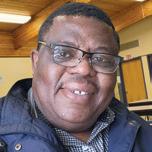

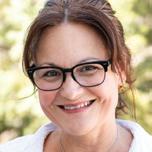
Christopher Afatsawo Jean-Louis Péhé
PAGE 34
Christopher Afatsawo est enseignant expérimenté en immersion française. Il est passionné par l'équité et la justice sociale.
Jean-Louis Péhé est enseignant de la Division Scolaire Franco-manitobaine. Avant cela, il a travaillé comme enseignant dans la Division Winnipeg.
Claudine Lambert
PAGE 36
Claudine Lambert, a Grade 2 French immersion teacher, has worked with many Indigenous organizations, families and communities. She believes that all children are special and unique and as educators, we need to develop positive relationships with all of them.

Maneesha Manuel
PAGE 38
Maneesha Manuel is currently in her 14th year as an educator. She has taught internationally in Singapore, in rural Manitoba, in Winnipeg, and in a First Nations community. She has held every role imaginable, from principal and guidance counselor to classroom teacher. She is currently teaching adult learners.

Roby Yeung
PAGE 40
Roby Yeung is a chemistry, biology, and math teacher in Winnipeg. He has taught in Malaysia, Hong Kong, and Ghana, and hopes to continue his travels with his family and share his passion for hockey wherever he goes.
FROM THE GUEST EDITOR

AMPLIFYING IBPOC VOICES
Allyson Fedak
As we navigate the complexities of our educational landscape, let us strive for equity and justice.
I am immensely proud to present to you our first-ever IBPOC Takeover Edition of The Manitoba Teacher, a groundbreaking initiative dedicated to amplifying the voices of Indigenous, Black, and members of colour (IBPOC) within our educational community. By dedicating an edition of a teachers’ magazine exclusively to IBPOC voices, we embark on a transformative journey toward educational equity and social justice.
Over the past year, the Equity and Social Justice Standing Committee (ESJSC) of The Manitoba Teachers’ Society (MTS) has been at the forefront of promoting equity among its members. It is through their dedication, support, and unshakable confidence in me that this edition has come to fruition. I extend my heartfelt gratitude to the ESJSC for their unwavering commitment to creating a more inclusive, equitable, and just educational landscape.
The planning of this issue, akin to anti-racism work, was complex, from the conceptualization of ideas, to the choice of the term “takeover” to describe the issue. Ultimately, the decision to use the term "takeover" was made deliberately and generated mixed feedback. While some expressed concerns about potential negative connotations, such as aggression or dominance, others embraced it for its connotations of agency and empowerment.
In this edition and beyond, it is our aim to ensure that IBPOC members feel valued, that their voices are amplified, and that their narratives are given the space they rightfully deserve. To us, the term "takeover" symbolizes the reclaiming of space, narrative, and visibility by those historically marginalized within educational discussions.
The task of ensuring that our publication represents the diverse experiences and perspectives of teachers in Manitoba has been both daunting and humbling. There was a palpable fear of encountering resistance of those seeking to uphold the status quo; fear of asking racialized members to make themselves vulnerable and requesting
of them the additional emotional labour of educating others; and fear of potentially falling short in our efforts to ensure that IBPOC member voices are not only heard and celebrated but compensated appropriately with the values of reconciliation and equity in mind. As the first guest editor tasked with this important mission, I keenly felt the weight of responsibility.
The necessity of this edition arises from the recognition of systemic inequities entrenched within our educational systems. IBPOC educators face numerous barriers that hinder their professional autonomy and growth and thus limit students’ access to inclusive education. Moreover, the absence of adequate IBPOC representation within schools perpetuates harmful stereotypes and denies learners the opportunity to engage with diverse perspectives. This edition serves as a catalyst for dialogue, collaboration, and solidarity within the educational community.
Most importantly, to the writers who contributed to this edition, I offer my sincerest thanks. Your willingness to share your stories and the vulnerability involved in recounting your experiences are deeply appreciated. You took a risk in sharing your truths, and for that, we are immensely grateful. This edition owes its existence to you. Without your courage and openness, this labour of love, empowerment, and justice would never have materialized.
In essence, this edition of The Manitoba Teacher underscores the urgent need for representation, inclusion, and justice within education. It is a declaration of solidarity, a commitment to amplifying historically marginalized voices, and a pledge to build a more equitable and empowering educational future for all.
As we navigate the complexities of our educational landscape, let us continue to strive for equity and justice, ensuring that every voice is not only heard but celebrated.
6 THE MB TEACHER | SPRING 2024
WITH GRATITUDE AND HOPE
Cynthia Taylor
May we continue to work together to build a world where equity is our greatest strength.

At the threshold of this new chapter for our beloved magazine, I am filled with a profound sense of gratitude and humility. It is with immense honour that I extend my deepest acknowledgment to the IBPOC members who have taken the reins of this publication.
For far too long, the voices of marginalized communities, including my own, have been relegated to the periphery of mainstream discourse. Our stories, experiences, and perspectives have often been overshadowed, overlooked, or dismissed altogether. However, today marks a significant departure from that narrative. Today, we observe a defining moment—a time when the voices of IBPOC individuals are not only heard but elevated and celebrated.
To the ancestors and trailblazers who dared to challenge the status quo, who paved the way for us to amplify our narratives and reclaim our identities, we honour your legacy. Your existence and resilience fuel our determination to dismantle systemic barriers and to carve out spaces where our voices can be heard and acknowledged as truth.
IBPOC MEMBER CONTRIBUTIONS
To the IBPOC members who have assumed leadership roles within this magazine, I extend my heartfelt thanks. Your insight, courage, and unwavering commitment to diversity, equity, and inclusion have breathed new life into these pages. By centering
the narratives of marginalized communities, you have paved the way for a more inclusive and representative landscape within MTS.
As a racialized woman, I recognize the significance of this moment. It is not simply a symbolic gesture but a tangible expression of change and growth. This issue continues the journey toward a more just, equitable, and inclusive future— one where every voice is valued, every story is told, and every individual is seen and heard.
A TRANSFORMATIVE ENDEAVOUR
In closing, I offer my sincerest thanks to all those who have supported and championed this transformative endeavour. May we continue to work together, in solidarity and in allyship, to build a world where equity is not only acknowledged but celebrated as our greatest strength.
SPRING 2024 | THE MB TEACHER 7
FROM THE VICE PRESIDENT
AHLAN WA SAHLAN: WELCOME A TRUE WELCOME GOES FAR BEYOND SIGNS
By Izzeddin Hawamda
Entering my new school in Canada, I was greeted by a bold ‘WELCOME’ sign, but the warmth it promised faded quickly. Alone and unseen, I navigated unfamiliar hallways, longing for the sense of belonging I left behind.
At the entrance to my new school, there was a big sign over the doorway that, in big, bold letters, said: WELCOME. I had just arrived in Canada with my mother and four siblings. We were finally reunited with my father who had made the journey to Canada a year earlier and had been working to bring us to be with him. Together the six of us lived in a small one-bedroom apartment and struggled to learn English and explore our new surroundings. My first day of school is a day I try not to think about often but when I do, I think of that sign. I always wondered if that ‘WELCOME’ was meant as a sincere, warm-embrace-type welcome or the type of
welcome you say to your cousins who come over too often and stay too long.
As I continued through the doors, past the welcome sign, I stepped into the hallway. The hallways of this school were much bigger than the ones I had known. Yet, with every step I took I could feel the walls closing in on me. It was as if the walls were questioning the reason for my presence. I walked through the hallway, a stranger. I did not know anyone, and they did not know me. In that moment, I did not even know myself. I had no idea who I was in this new environment, or who I was expected to be. I looked to the window on the left where the
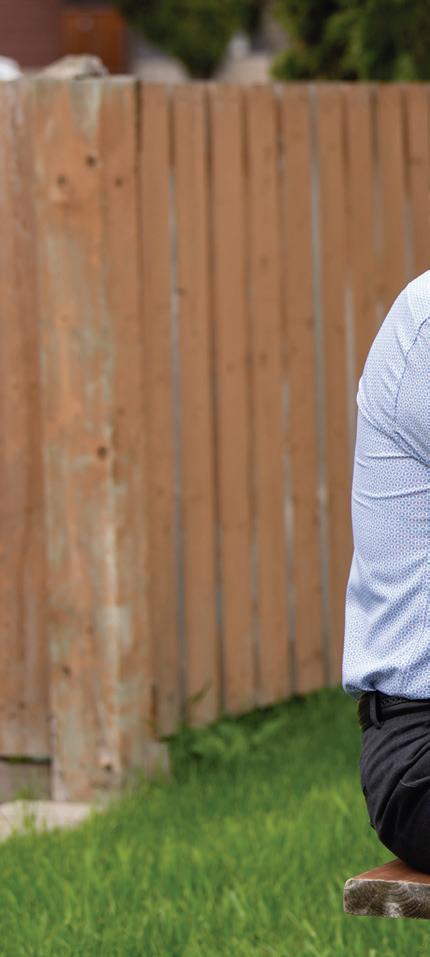
sunlight shining through offered a moment of relief from the ever-tightening walls, but in an instant it disappeared. The light faded to darkness. A clear sign, to my sixteenyear-old mind, that I was not meant to find comfort in this space. I did not belong.
FEELING LOST
I was as lost as I had been at Winnipeg airport the day I arrived, a month earlier. I was nervous, but mostly, I was upset that my dad was not there with me. He had brought me to this country and then sent me to fend for myself. I now understand that he felt that he would have made my first day worse. He
8 THE MB TEACHER | SPRING 2024

thought he would have embarrassed us both because like me he felt lost. Unlike me, he was a grown man and certainly would have drawn attention wandering around a high school. Eventually, a teacher noticed me in the hallway and helped me find my classroom. I arrived at the classroom door and waited to be greeted. Where I come from it would be rude to enter a classroom without being invited in. The teacher was busy teaching and never acknowledged my presence. I felt invisible.
After leaving that class, once again I was lost, but it was just about prayer time, so I went in search of a prayer room. Where I
came from this was a typical and communal part of the school day. But, in my new school, my new community, my new country, I was alone.
I tried knocking on doors, made gestures, and used the limited English I knew to try to explain that I was looking for somewhere to pray. I grew frustrated and sad. I wished to be back at my old school where I never had to wander aimlessly looking for a place to pray. It was always there, shared by everyone. The teachers even volunteered to take turns bringing fresh flowers and cleaning the room so that it was ready for a new day.
NO PLACE LIKE HOME
Nothing looked like it had back home. I had just left the West Bank, as a refugee, in the midst of the Second Intifada. The place that I had called home was beautiful. My family owned farmland and I grew up in a village where I knew everyone, and they knew me. I could look out my bedroom window and look at the hills and mountains. I would go for long walks, sit by the creek, and bring back flowers for my mom and grandmother.
But in the months before we left, conflict began again and I arrived in Canada with
SPRING 2024 | THE MB TEACHER 9
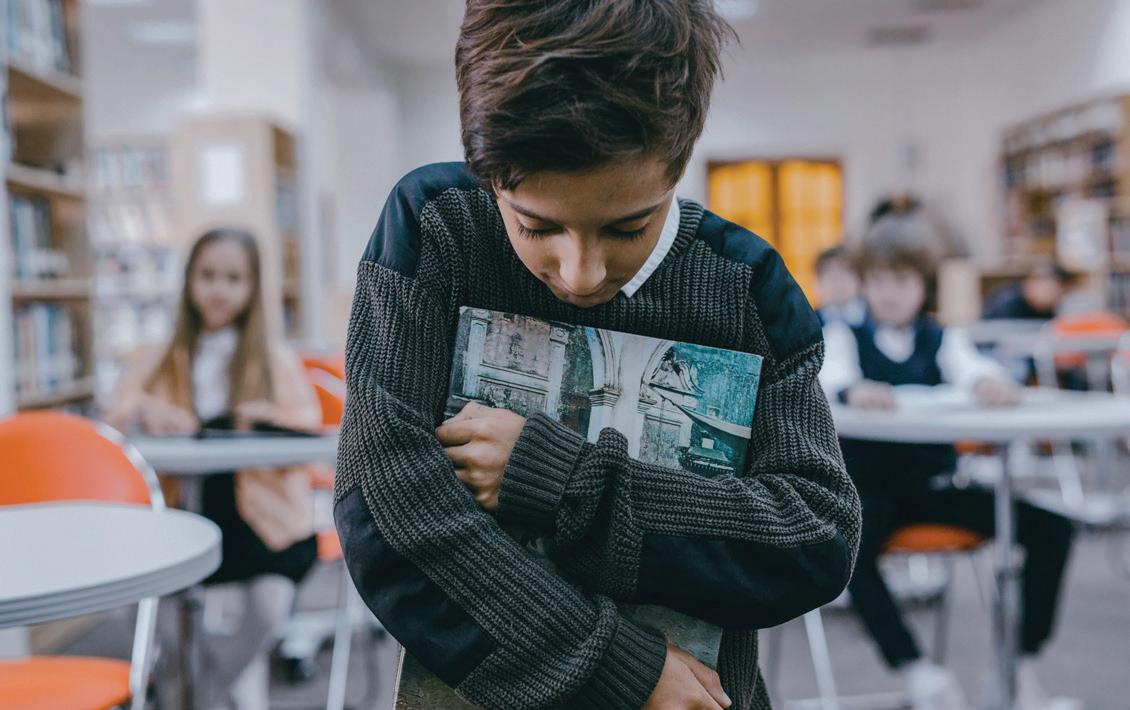
vivid images of F16s flying overhead, armed tanks, and hundreds of soldiers flowing into the streets. After arriving in Canada, I had many sleepless nights wondering if the family and friends I left behind would be safe and dreams of violence that had erupted in the days before we left.
In my dreams I could still smell the distinct odour of tear gas. I could hear the voices over the loudspeakers from the Mosques telling people to fight the invasion with everything they have. To this day, these are things I have never forgotten.
Nobody at my new school invested any time or effort into finding out how to pronounce my name or learn about my history. Nobody asked about my journey or my experiences or what was important to me and I never had the opportunity to share the beauty of my language, my religion, or my culture.
STRENGTH AND COURAGE
Every morning, I woke up and tried to gather the strength and courage to get out
of bed, to face the day ahead of me, and to come home and convince my parents that everything was going smoothly, “I’ve got this. I can do this.”
My teachers and classmates all thought I was older than the other students in my classes and it was assumed that because I did not speak English well that I was uneducated. I could feel the glares and judgemental looks and I could hear the whispers about my ripped and worn-out clothes.
Little did they all know I had won awards for writing and poetry back home. I was an avid reader of history and political books. I was fascinated by the theories in science and math (though, I have never been strong at calculation). I had learned many of the topics covered in my classes, but I had learned them in Arabic.
I went from a strong, passionate student, eager and willing to learn, to someone who realized they would never treat me like the other students unless I resembled them, unless I gave up everything that made me
who I was: my language, my religion, my culture, my struggle, and ideally, my accent. I drew further inward and, like the hallways and the windows on my first day of school, I could feel that I was closing in on myself and all the hope I had went dark.
WELCOME SIGN
I have come to the realization that the ‘WELCOME’ sign that ushered me into my new Canadian school was not what it appeared to be. I was not welcome in the sense that I could come as I was to be embraced and celebrated and belong simply for being me. I was not ‘welcome’ in the education system.
I was tolerated.
I have always wished that when I arrived at my new school in Canada and looked up at the big, bold ‘WELCOME’ sign that someone would have noticed me standing there, noticed that I was in awe of this space, and simply asked me to write ‘AHLAN WA SAHLAN’ to truly welcome the next student like me.
10 THE MB TEACHER | SPRING 2024
MULTIRACIAL IDENTITY
MY NOT-SO-NUCLEAR FAMILY
By Allyson Fedak
As a biracial child with a large blended family, the complexities of my identity were woven into the very fabric of my existence.
My parents, all hailing from distinct cultural backgrounds, brought together a tapestry of traditions and experiences that shaped my perception of family from an early age. Growing up, I straddled the line between two worlds, navigating the delicate balance of embracing my heritage while grappling with the expectations of a society that often struggled to define me. These formative years laid the groundwork for my journey—a journey that would lead me down a path of anti-racist work within my own family as an adult and a single parent of multiracial children.
From the moment my children were born, I knew they would navigate a world that might not fully recognize or validate their multiracial heritage. Personally, I am intimately familiar with the nuances of straddling multiple racial identities and the complexities that come with it. Yet, raising multiracial children has presented its own set of challenges, as I try to cultivate in them a deep cultural pride and belonging. I am also engaged in my own learning process to educate them about a culture to which they belong, but I do not, all while living in a predominantly white cultural framework.
Navigating the educational system has been a source of frustration and concern. Despite efforts to promote diversity and inclusion, many schools still adhere to Eurocentric curricula that fail to adequately represent the histories, cultures, and contributions of non-white communities. As a parent, I've had to advocate for my children to receive an education that reflects the richness and diversity of their backgrounds. This undertaking is often draining, a burden not all parents of racialized children are equipped to bear. Yet it remains vital for ensuring that my children encounter positive reflections of themselves within their educational experiences, and so I continue to educate
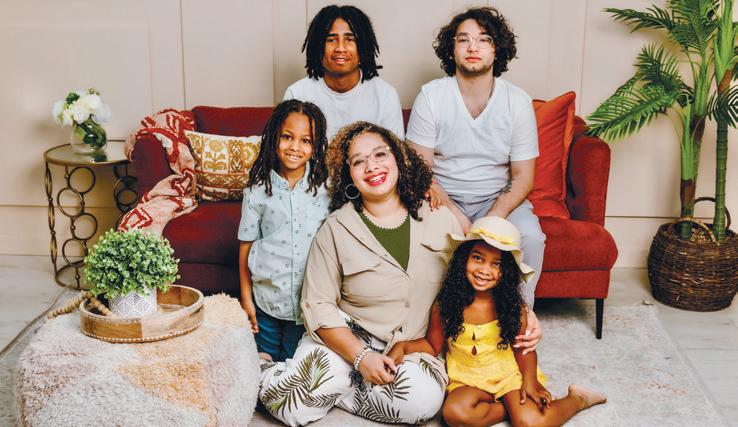
my children’s teachers and my peers on the richness of diversity and the benefits to all in building understanding.
Beyond the classroom, my children and I have had to navigate the complexities of race and identity in our daily interactions with their peers and adults alike. From casual comments about who they do or do not look like, to more overt forms of discrimination, they have been forced to confront the harsh realities of racism and prejudice at a young age.
As a parent, it can be heartbreaking to witness. Yet, it's also an opportunity for discussions about the meaning of family, values, and cultural pride, creating growth, resilience, and empowerment as we navigate these challenges together as a family.
Despite the many challenges we face, there is also immense joy and beauty in raising multiracial children. Watching them embrace and celebrate their diverse heritage and learning along with them brings me immeasurable pride and happiness. Whether it's learning about their ancestors' traditions, cooking traditional
dishes together, or participating in cultural celebrations, we find strength and solace in our shared identity as a multiracial family. My sister affectionately and jokingly calls our family “Fifty Shades of Brown”, a title that we wear with pride in a world that questions and scrutinizes our not-so-nuclear family.
As I continue on my journey of raising multiracial children in a white-dominated Eurocentric culture, I am reminded of the importance of resilience, self-love, and community support. Anything I have learned about my own and the cultures of my children I owe to the knowledge of my family or to gracious community members who have been willing to teach me.
Together, we navigate the complexities of race and identity with courage, grace, and determination. And while the road may be long and fraught with challenges, I am confident that my children will emerge stronger, more resilient, and more empowered to embrace their multiracial identities with pride and dignity.
SPRING 2024 | THE MB TEACHER 11
THE PATH CONTINUES BEYOND SELF-DOUBT
By Clifford Weekes
Ever felt like you’re constantly needing to prove yourself? Like an imposter at the front of your own classroom? You’re not alone. Through self-discovery and navigating the pressures of representation I have found solidarity and hope in a changing educational landscape.
Do you ever feel like there’s a little person at the back of your head, sipping on a drink and doubting every move you make? That constant need to prove yourself — is it familiar? I’ve been an educator for 14 years — 12 in the classroom and two as a Divisional Teacher Team Leader focusing on anti-racism initiatives. Throughout these years, those feelings have lingered. I used to think maybe everyone felt this way but just didn’t talk about it. Maya Angelou’s quote, “Forgive yourself for not knowing what you didn’t know before you learned it,” often comes to mind. I wish I had known that others shared these feelings.
As a racialized educator, I identify as a Black, Able-Bodied person. My family has roots from the island of St. Vincent in the Caribbean. In the spirit of Truth and Reconciliation, I acknowledge the harms and mistakes of the past, and my commitment is to engage in the Indigenous culture to understand their injustices and see the parallels they have with the Black community.
Racialized educators carry extra pressures leading to self-doubt. Walking into a room and not seeing many people of colour can trigger questions like, “Do I belong here?” or “Why am I here?”
FIRST RACIALIZED PERSON IN A SPACE
Another pressure arises when you’re the first racialized person in your space or when you're expected to carry the burden
WITHIN THESE DOUBTS, I FOUND SUPPORT AND BELIEF FROM PEOPLE WHO RECOGNIZED MY MERITS. FOR EVERY DOUBTER, THERE WERE TWO SUPPORTERS PUSHING ME FORWARD.
BEING A RACIALIZED EDUCATOR BRINGS JOY IN OFFERING UNIQUE PERSPECTIVES AND BEING AUTHENTICALLY ONESELF IN A CHANGING WORLD.
of discussing certain topics because of your background. The fear of being seen as a diversity hire, merely a token representation, also weighs heavily on the mind.
One significant source of self-doubt for me was questioning whether I was a diversity hire. It wasn't until later that I realized others shared the same thoughts. Despite being Black, I failed to recognize diversity among my racialized colleagues.
Instead, I joked about being the token hire, reminiscing about my school days where racial diversity was scarce.
EXPLORING MY IDENTITY AS A BLACK MAN
It wasn’t until 2020, the year my daughter was born, and George Floyd was murdered, that I began to explore my identity as a Black man. I realized the importance of engaging with discussions about race and identity, as Maya Angelou aptly put, “Do the best you can until you know better. Then when you know better, do better.”
Within these doubts, I found support and belief from people who recognized my merits. For every doubter, there were two supporters pushing me forward. Being a racialized educator brings joy in offering unique perspectives and being authentically oneself in a changing world. Positive changes are happening, with more representation than ever before. It’s important to remember that you’re not alone—find your support system.
STAND WITH THOSE WHO BRING DIFFERENT PERSPECTIVES
If you’re part of the racialized community, know that you’re where you are for a reason. And if you’re not, stand with those who bring different perspectives, ensuring everyone feels heard.
12 THE MB TEACHER | SPRING 2024

SPRING 2024 | THE MB TEACHER 13
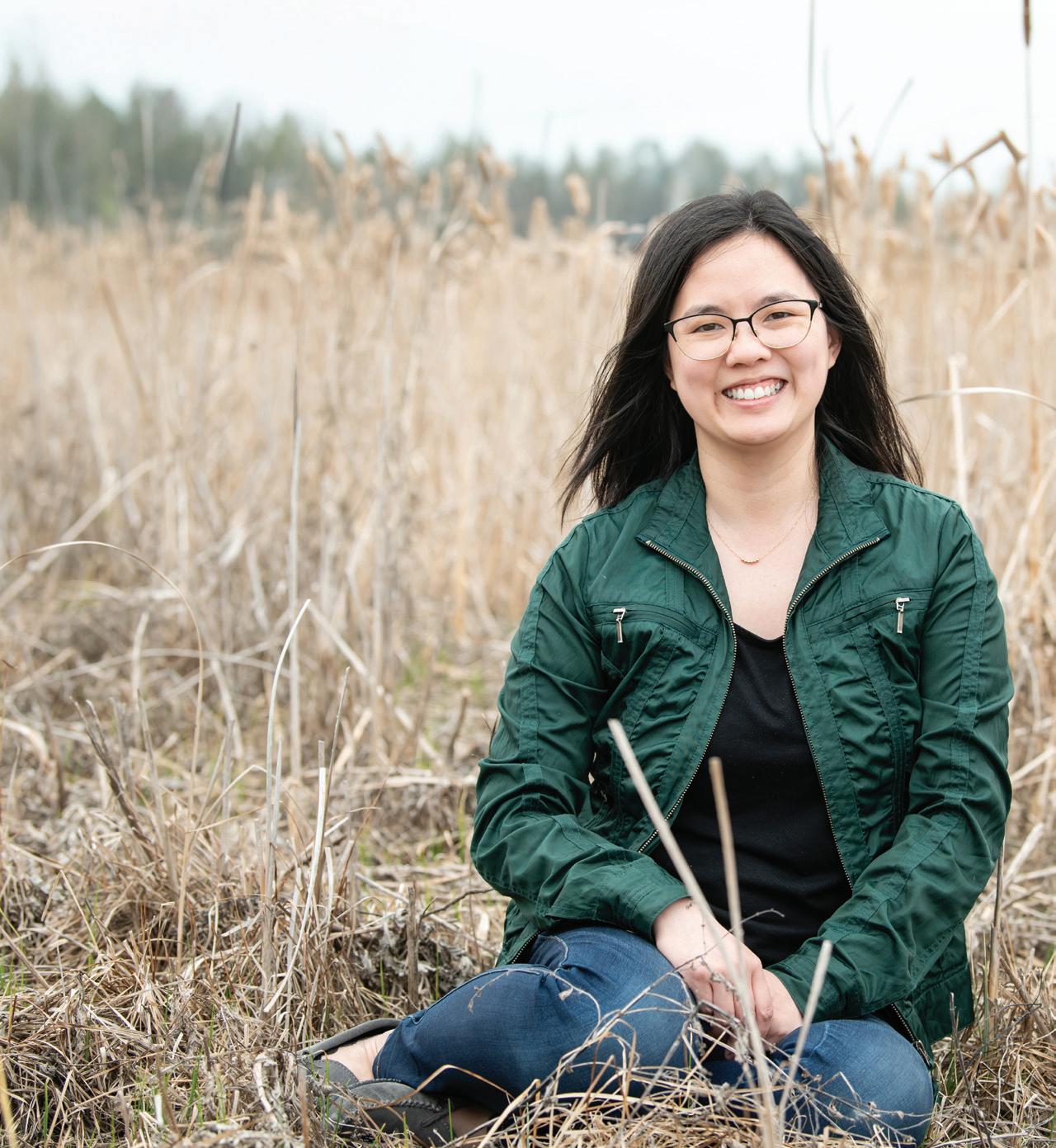
14 THE MB TEACHER | SPRING 2024
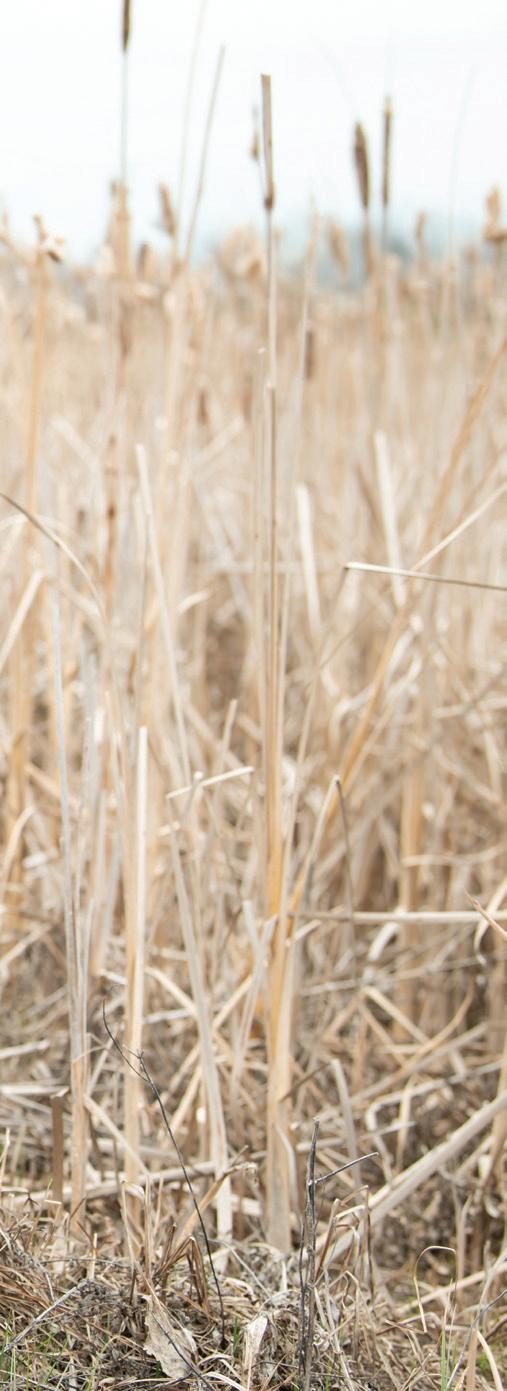
COUNTER STORYTELLING IN SCIENCE EDUCATION
By Peiki Loay
Storytelling is central to the human experience – helping us make sense of the world and our own lives. Stories can be found across curricular areas – including in the science classroom. Perhaps you have listened to a riveting re-telling of Archimedes’ bathtub eureka moment, heard the story of Galileo dropping weights from the Leaning Tower of Pisa, or are familiar with the electrifying controversy between Galvani and Volta. But whose stories are shared and celebrated while others remain invisible?
When we understand science as a sociocultural activity, we can notice the ways science classrooms reinforce the worldviews and contributions of the dominant culture. When our science curriculum neglects to significantly honour Indigenous ways of knowing science, Euro-Western ways of thinking and being are privileged. When only the stories of white, male scientists are highlighted in resources, it sends the message to learners that science is not for those who identify otherwise.
This cultural dissonance that can occur has been documented in numerous science education research studies. All students deserve to see themselves reflected in their science learning, and science education has an important role in advocating for a more socially just and equitable world.
SPRING 2024 | THE MB TEACHER 15
Counter storytelling is one way we can (re)center the voices that have long been relegated to the margins in mainstream science classrooms.
WHAT ARE COUNTER STORIES?
Counter stories are stories that challenge the dominant cultural narrative. They are stories that confront power and privilege. They are the stories of marginalized individuals and communities. A key concept of critical race theory (which, in simplest terms could be understood as a lens for making sense of how racism operates in society), counter stories can help paint a more complete picture of race and power relations within our institutions.
MOBILIZING COUNTER STORIES IN SCIENCE CLASSROOMS
As science educators, we can leverage our privilege to center IBPOC (Indigenous, Black, People of Colour) voices. One way of doing this is by inviting racially diverse scientists to share their science stories. Through various collaborations, my students and I have been able to learn about the joys and challenges encountered along different science journeys. Together, we have been able to grow our understanding of how science is embedded within Indigenous storytelling and better understand how women of colour are leaders in various science industries.
In my classroom, we also access counter stories through diverse text and media resources. I love sharing Robin Wall Kimmerer’s botany journey by reading from Braiding Sweetgrass for Young Adults . Her plant knowledge and ability to weave Indigenous and western sciences together, truly, are gifts.
We have also learned about the night sky and structures from local star lore expert, Wilfred Buck, whose videos are very accessible online. Additionally, students are invited to discuss and think critically about the story of Henrietta Lack’s HeLa cells ( The Immortal Life of Henrietta Lacks ), as well as the systemic barriers encountered by Patricia Bath
IN MY CLASSROOM, WE ALSO ACCESS COUNTER STORIES THROUGH DIVERSE TEXT AND MEDIA RESOURCES. I
LOVE SHARING ROBIN
WALL KIMMERER’S BOTANY JOURNEY
BY READING FROM BRAIDING SWEETGRASS FOR YOUNG ADULTS .
on her journey to improve eye care ( The Girl with an Eye for Eyes ).
We can also provide opportunities for learners to value storytelling both as a method of science inquiry and way of demonstrating their science learning. For a science project, a group of my students were inspired to collect and analyze counter stories from their community to make sense of healthrelated inequities. Students have also created their own science stories in the form of comics or short stories to communicate their personal and cultural understandings of science.
SHARING OUR COLLECTIVE COUNTER STORIES
As a racialized teacher, I also make efforts to embed my own counter stories into my teaching practice. By sharing my experiences growing up as a secondgeneration Chinese Canadian from a family of war refugees, I invite my students to share their own cultural stories and histories.
With vulnerability, I also share with my classes the moments of racial discrimination I have experienced both as a young person and now educator living and working in predominantly white communities. Together, we connect and interrogate the intersectional oppressions that continue to persist within our schools.
It is important for our students to know that their teachers are also learners trying to grapple with the complex, nuanced, and messy work of understanding diverse worldviews and ways of knowing science. There is so much that I have yet to understand! There is excitement and curiosity, but also days of frustration and tears.
Learning takes patience and time, and I, too, am working to decolonize my western science lens by unpacking my own positionality and biases, connecting with diverse community members, learning through reading and scholarly work, trying new pedagogies, and learning from my (many) mistakes.
WHAT STORY WILL WE TELL TOGETHER?
I hope that we can all come to value more diverse ways of knowing science by interrogating our own teaching practices. Can we more intentionally celebrate and reflect on the stories of IBPOC scientists? Can we create courageous spaces to dialogue with our racially marginalized students and colleagues about their conceptualizations of science and scientists? Can we make visible the ways in which whiteness permeates science education?
Although the challenges in education are real ranging from time and access to resources to resistance from others to unfamiliar ideas, socially just science pedagogies must be prioritized. For those already engaged in this important work, I hope you can find solidarity and encouragement in knowing that you are not alone. To colleagues who have yet to embark on your own journeys, I urge you to (re)consider the story you will tell one day. Maybe it will be a story of how you looked away and reinforced the status quo… but maybe, instead, it can be the story of how you overcame your own fears, came to see our struggles as your own, and leaned into championing a more socially just and equitable world for us all.
16 THE MB TEACHER | SPRING 2024



ARE YOU A RETIRED/ TEACHER?
U OF M IS CURRENTLY HIRING PRACTICUM ADVISORS TO SUPPORT AND MENTOR TEACHER CANDIDATES.
We are always seeking to strengthen and diversify our fabulous advising team and we encourage Black, Indigenous and People of Colour (BIPOC) educators to join the UM Faculty of Education as a Practicum Advisor!
BIPOC educators and advisors play a critically important role in supporting BIPOC pre-service teachers and preparing them for the profession.
Practicum and Partnerships Office mail: practicum.education@umanitoba.ca


SPRING 2024 | THE MB TEACHER 17
MAKE A DIFFERENCE...JOIN OUR TEAM! 2024 on/community-partners/ practicum-advisors-mentor-teachers
Find and filter 40+ free or low-cost, peer-reviewed, curriculum-matched classroom resources centred around Indigenous topics. A
LIGHTEN YOUR LOAD WITH R4R: R4R.ca Resources for Rethinking A project of LSF Learning for a Sustainable Future
DATABASE FOR TEACHERS
INVISIBLE MINORITY
By Kathy Simcoe
Until recently, I never considered myself racialized, navigating an identity “a little bit Indian” amid adoption and disconnection from my birth family.
My first teaching role in a First Nation school exposed me to stark educational disparities, contrasting my privileged public school experiences. This journey has driven my commitment to Indigenous education, highlighting the necessity of allies and cultural competence in creating meaningful change.
Until recently, I would never have considered myself racialized, as my identity has never been that simple, always existing somewhere between the cracks. Being “a little bit Indian” was casually mentioned to me as a child by my adoptive parents. At the end of the 60’s Scoop era, their belief, backed by the Canadian government, was that I was better off where I was, with no knowledge of my birth family. It was not until adulthood that I learned that I qualified for status under the Indian Act, yet people had no idea unless I told them. From there on, I thought of myself as an invisible minority.
“WHITE-PASSING”
I acknowledge that being a “whitepassing” Indigenous person has afforded me certain benefits, such as seldom if ever experiencing overt racism associated with colour. I essentially had the luxury of being able to choose whether to be Indigenous. However, this social capital came at the cost of a cultural identity.
My first teaching job at my home First Nation school had been an overwhelming eye-opener to the disparity between the
privilege that I had enjoyed in the public school system and the reality for those educated on a First Nation.
I felt too demoralized and ill-equipped to do much good, with little cultural exposure or knowledge other than what I saw on “North of 60.” Sure, I had along my journey attended a few powwows, a sweat lodge and learned how to make dreamcatchers and moccasins, but I felt very much like a pretendian
Most days, I can appreciate that more and more educators are seeking ways to infuse traditional knowledge in their practices. I listen to people outside of education also looking for answers about Indigenous issues. But on a day when I feel the weight of my full-time classroom teaching job and extracurriculars, I concur with Niigaan Sinclair’s words, in his article “Those People, Our People:”, “It’s important to talk with people where they’re at but frankly, it’s exhausting to constantly do the work schools, government and society should be doing.”
Being a lone Indigenous teacher means, on one hand, there is little danger of being criticized for getting it wrong, but on the flipside, there are few opportunities for
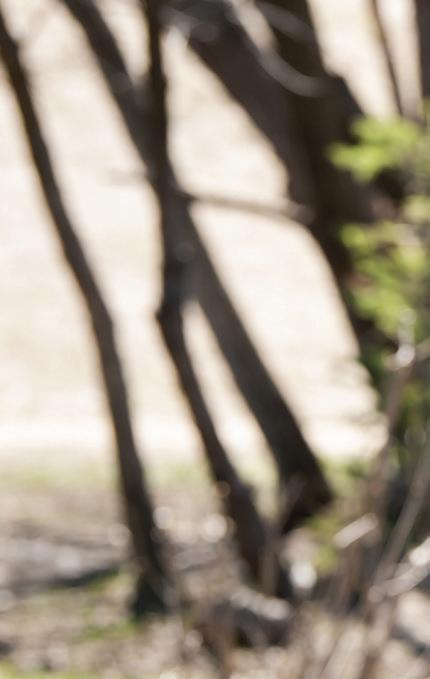
collaboration, and mentorship.
However, I would not want to suggest that my experience has been simply a lonely road. Albeit relatively late in life, I have sought out many cultural learning experiences and met many mentors through the MTS Workshop on Workshops, a Cultural Competence and Confidence course, and Blanket Exercise training to name a few.
I sometimes wonder how my own school experience would have been different had I had even one Indigenous teacher as a mentor, or at the very least some positive representation of Indigenous culture other than what I saw highlighted by the media.
INDIGENOUS EDUCATION DISPARITIES
From listening to teachers involved in Indigenous education from around the province, I have come to realize there is a disparity not only between urban and rural divisions, but also from one rural school division to another.
Some divisions have Indigenous Education support staff, some do not. Also, if a rural
18 THE MB TEACHER | SPRING 2024

high school has feeder schools from First Nations communities the need for Indigenous education is clear, and supports are more likely to be put in place.
For rural divisions with no First Nations communities nearby and a less visible Indigenous population, the need is seen to be less significant. This stems from a myth that where there are few Indigenous students and families, there is less need for Indigenous education.
Indigenous education is not just for the benefit of Indigenous students. As Justice Murray Sinclair states, “Teach children about the History of Canada (…) so that everyone knows why things are the way they are. . . because no one owns this History, it belongs to all of us.”
The more you learn about colonization, systemic racism, and decolonization, the more impatient a person can become at the slow rate that the wheels of education turn.
The other good news is that I have, over my relatively short career in education, seen more and more allies and advocates emerging. There is more capacity and understanding with regards to Indigenous
education and education for reconciliation.
With so few Indigenous teachers in the field, allies and advocates are crucial for the work to continue. It is important to be mindful as non-Indigenous allies of when to follow, when to walk alongside, but to avoid walking in place of Indigenous people by leading the charge.
Naturally, there remains for nonIndigenous teachers, the fear of getting it wrong. Therefore, it is very important that space is created for more training and for institutions to be open to diverse ways of educating our youth as well as our educators.
COLONIAL FOUNDATIONS IN EDUCATION
Our colonial foundations in education have dictated that education must be delivered only by professionals trained in that same colonial framework. However, the traditional role of community members has been to teach and support, and they are often an untapped resource.
Finally, know that even with the best laid plans, mistakes are inevitable, so if you make
a mistake make it one of commission rather than omission.
Regardless of how I am identified by others, as a racialized person, visible or invisible, I have chosen my path. It is to weave Indigenous perspectives and education for climate change into my subject areas to build capacity in my students. Another is investing my time in helping to build capacity in my colleagues in my role of catalyst teacher for Treaty training for our division.
Finally, in my current role as Indigenous Voice and Action chair for our local teachers’ association, I have found true allies. We have formed an Indigenous Voice and Action committee through which we are working to address needs and offer support to members looking for ways to bring Indigenous ways of knowing into their practices.
The effects are not always noticeable and are rarely immediate. The same could be said for supporting and mentoring other educators. Often it feels like words and actions fall on deaf ears, and it seems like a long, lonely stretch of road. However, we are all travellers, and unbeknownst to us, our actions just may become part of someone else’s journey.
SPRING 2024 | THE MB TEACHER 19

20 THE MB TEACHER | SPRING 2024
TURNING THE PAGE: TRANSFORMING LIVES AND LIBRARIES
By Pardeep Duggal
The books on the shelves had characters that did not look like me, written by authors that did not look like me. There were no characters of colour, or if there were, they were the side character, or a stereotyped version of a culture.
The year was 1991 and books had suddenly become a part of my life in a big way. Home was turbulent at times, and I needed an escape. Books were my escape, and so the library became like a second home. Some of my favourites were The Baby-Sitters Club, Sweet Valley High, The Boxcar Children, and as I got older it was always a book about romance or teen angst. These books kept me going through those adolescent years. Later in life, I realized that I had internalized messages that came with reading those books.
The books on the shelves had characters that did not look like me, written by authors that did not look like me. There were no characters of colour, or if there were, they were the side character, or a stereotyped version of a culture.
WHITE DOMINANT NARRATIVE
What that told me was that society valued white, blonde, blue-eyed girls. The dominant narrative was told from the white perspective, and it was a world with which I was not familiar. The characters would do things or say things that I was not allowed to do because of my culture.
I desperately wanted to fit in and be valued in the world I was living in and so that is where the internal struggle came. At school, I tried to be that girl in the book, but at home I was very much Indian. I did not know who I was or where I fit.
Rudine Sims Bishop, a professor emerita at
Ohio State University wrote in a piece titled Mirrors, Windows, and Sliding Glass Doors, “when children cannot find themselves reflected in books they read, or when the images they see are distorted, negative, or laughable, they learn a powerful lesson about how they are devalued in the society of which they are a part.”
She also wrote, “Children from dominant social groups need the books as windows onto reality, not just imaginary words. They need books that will help them understand the multicultural nature of the world they live in, and their place as a member of just one group, as well as their connections to all other humans.”
The year is now 2024, and I am a teacherlibrarian in the very same division I was a part of as a student. The best part of my job is I get to shop for books to add to our library collection.
CHARACTERS OF ALL COLOURS
When I go to a bookstore, I stand back looking at the shelves filled with colourful covers, and as I step closer, I see characters of all colours on the cover, author names that represent different ethnicities, and stories that are real to all types of cultures, faiths, and experiences.
Those books go into my cart, and then on to the shelves of my high school library. Schools are becoming increasingly diverse, and I know firsthand that those diverse students
need to see themselves represented in the texts at our school. They need to know that their stories matter and bring value to the community. Students need to have access to stories that are also different from theirs to enrich their world view.
One day, a few months back, as I was setting up a display of new books in the library, a Grade 12 student came and stood beside me. Each book was different. Each character was different. Her eyes went to the book of an Indian girl dressed in a beautiful sari twirling around dancing. My eyes followed hers to the book. “She looks like us!” I smiled and said, “Yep, she does. I am glad you have a book with someone who looks like you. It is important.” She followed up with, “You’re making a difference here!”
I was elated and felt my inner brown skinned girl fill up with joy! I now read all the books-those with characters that look like me, and those with characters that don’t. I read books with 2SLGBTQIA+ characters, and books with marginalized characters to help understand how to be an ally.
Expanding our minds to stories that reflect anyone we may encounter will build empathy, and in an empathetic world there is love and kindness for all. Representation matters.
“When there are enough books available that can act as both mirrors and windows for children, they will see that we can celebrate both our differences and our similarities, because together they are what makes us all human.” - Rudine Bishop
SPRING 2024 | THE MB TEACHER 21
WHERE I’M FROM
By Allyson Fedak
I am from the steelpan.
From oil and pitch stolen from the land I am from the robbed lands of paradise still fragrant, green, and warm.
I am from mango trees with mangoes, So juicy and so sweet. They drip down my nieces elbows and revive them from the heat.
I’m from rhythm, rebellion, resilience, every fete, and every lime from Kenny and from Vernon and from Athertons farther down the line
I’m from the spirited debates
And the music that makes you wine. The cousin list that never ends, And the bumpy bush road rides
From the tiny but mighty women, men with fire in their souls
Religion in the church and ancient beliefs in the home
I’m from Quarry, T&T where my grandparents built their home along the trace, not by birth but by the love I feel deep within that pulls me to this place
Doubles - heavy pepper, roti, and saltfish too
From the father who left to build a new life. From the family I love but never knew The big brother and cousin who held me when I reached the land that called throughout my life, The Island that spoke through the photos on the tv stand, and the phone calls on the phone, and the sound of the steelpan on winter nights calling me back home.
‘Where I’m From’ is a well-known and disseminated poem by George Ella Lyon which focuses on personal identity. In classrooms around the world, the poem’s template is used to encourage a deep dive into individuality, prompting exploration of one’s background, home, childhood, upbringing, and family culture. Many free templates are available online. https://iamfromproject.com/
IDENTITY:
SO MUCH MORE THAN “WHERE I AM FROM”
By Allyson Fedak
This poem is a testament to my journey “home” to Trinidad and Tobago, the land of my father and ancestors, a land that has whispered to me throughout my life, despite my upbringing in Winnipeg. It is the story of stepping off the plane to the humidity and the smell of tropical plants and then being hugged by my oldest brother for the first time in my life.
It is the story of finding a missing piece of my heart, realizing that the love of family transcends borders, and resonates just as strongly as the bonds forged in Canada over the years.
Through fragments of memories and our family name, this poem pays homage to the richness of our shared history and the depth of our collective love. There are pieces that may only be understood by members of my family, but also tidbits understood by other Trinis like doubles (chickpeas between two flatbreads) by the roadside, or an evening lime (hangout).
Other experiences may be understood by many people who have migrated from regions where mangoes grow ripe and drip to your elbows or where bush roads are bumpy and plenty. It is a poem about me and my identity and a poem about history and the complexities that brought me to where I am today.
The poem begins with “I am from the steelpan.”
You may ask why I would choose such an item to be “from” but the steelpan is an important symbol in this poem as well as an important symbol in Trinidad. The steelpan is the national instrument of Trinidad and Tobago and it is a symbol of rebellion, cultural expression and, in my family, a symbol of joy.
The steelpan was created during a time when the colonial government imposed restrictions on African drumming throughout the Caribbean. The steelpan originated from discarded oil drums, repurposed by Afro-Trinidadians who were
denied access to traditional percussion instruments.
In the early 20th century, the demand for oil in the area was high. Trinidadians took discarded oil drums from refineries and turned them into instruments of joy. Being “from the steelpan” for me means being from my ancestors; being from the pillaged paradise where corporate greed has pulled oil from the earth and damaged land and seas, where colonialism has tried to steal the culture from our blood; but being from a people who rise above, whose blood holds memory, resilience and joy.
From a family whose love runs deep, whose resilience is unmatched, and whose music plays loud.
The British Columbia Teachers’ Federation Magazine BIPOC takeover issue highlighted the BIPOC 2050 project and George Ella Lyon’s poem “Where I’m From,” alongside the I am from project.
This poem speaks to the question that many IBPOC people hear often “Where are you from?” The question, although often well intentioned, can be frustrating for many IBPOC.
By asking this question there is an implication that the person being asked doesn't belong here and can reinforce feelings of exclusion and alienation, particularly for individuals who have been historically marginalized or discriminated against based on their race or ethnicity.
The intention behind the question is often well intentioned and an attempt to connect with the racialized person. However what often happens is the asker defines the identity of the IBPOC based on what the asker has experienced or heard about a place beyond Canada.
As such the question can be perceived as a microaggression, which is a subtle form of discrimination or derogatory remark directed at marginalized groups. While the intention behind asking may not always be malicious, the impact can still be harmful, contributing to feelings of racial insensitivity or discrimination.
Of course, for many IBPOC race and culture tied to a different homeland can be huge part of their identity but identities are complex, and the question can reinforce harmful assumptions about people based on what the asker
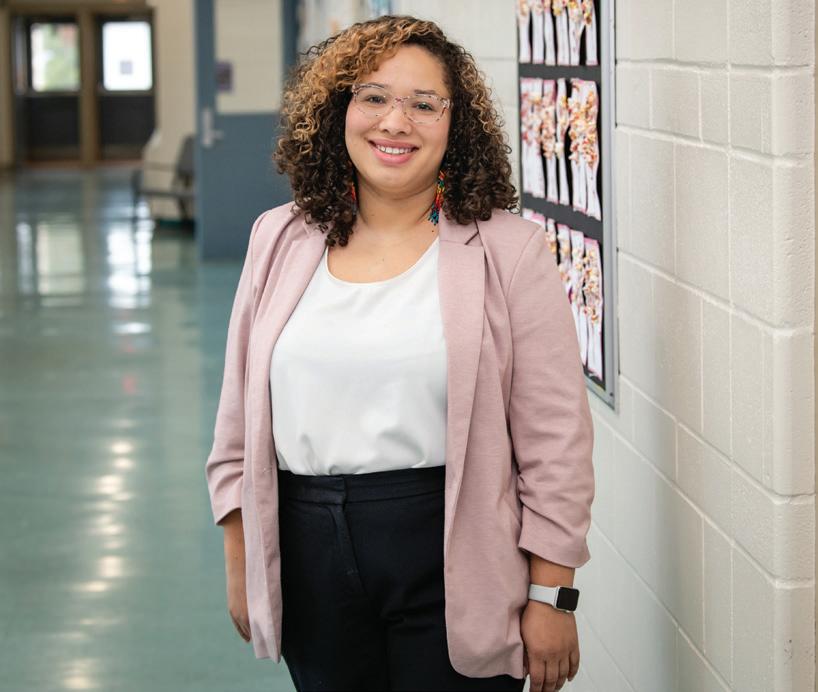
has experienced or heard about a place beyond Canada.
Instead of asking the potentially offensive question “where are you from” there exist more respectful and inclusive approaches to learning about someone's cultural identity through conversation.
One tactful approach is to directly inquire about their heritage or cultural roots. For instance, one could ask, “What is your cultural background?” or “Could you share a bit about your heritage?”
These queries are more specific and sidestep the inadvertent negative connotations associated with the former question.
However, it’s essential to recognize that not everyone may feel comfortable discussing their cultural background, especially with someone they’ve just met or if they have experienced discrimination in the past. In such cases, it’s best to refrain from asking about it altogether. Instead, focus on building a genuine connection through conversation.
Engage in discussions about topics
that allow individuals to share aspects of their cultural identity in an authentic way. For instance, you could ask about their family, upbringing, or experiences growing up. Questions like “Tell me about your parents” or “Where did you grow up?” can provide insights into a person’s cultural background without making them feel othered.
Additionally, you could inquire about what home means to them or where they feel a strong sense of belonging. This opens the opportunity for individuals to share personal stories and perspectives on their cultural identity in a more organic and respectful manner.
Approaching conversations with curiosity and kindness, while respecting boundaries and individual comfort levels, is key to learning about someone’s cultural identity respectfully and inclusively. Ultimately, we need to remember that no person owes us their life stories and if you get the feeling that it might not be ok to ask, don’t.
SPRING 2024 | THE MB TEACHER 23

FINDING OUR WAY BACK THROUGH A LIVED CURRICULUM
By Alison Lubinski
My understanding of identity has evolved from external influences to a deep connection with my culture and language. Rediscovering identity as Indigenous peoples is essential, guided by the wisdom of Elders and Knowledge Keepers. This journey fosters a sense of belonging and holistic healing.
Boohzoo! Waabijiizi Gookooko’oo Manido Ogichidaakwe. Hello! My traditional name is Grey Owl Spirit Warrior Woman, and I am from the Bear (Makwa) Clan. My English name is Alison Lubinski, I am a proud Métis (Scottish, Irish and Cree descent) woman who has learned through personal struggles and her own trauma that finding one’s identity is a necessary journey that helps us find a sense of belonging.
My understanding of identity has changed over time.
When I was younger, I felt my identity was defined by my friends, where I lived, and the things I had. As I grew older and began connecting with my culture and language, I found that my identity evolved through the rich cultural and social influences that I began to immerse myself in. Identity is a term we are rediscovering as Indigenous peoples. Knowing where we come from, whose land on which we occupy, and who we are as First Peoples, is leading us on a new path in education.
Today, I am beginning to walk a different path, one that includes the rich understanding of the history of my people and my family, and the guidance and support from nurturing Elders and Knowledge Keepers. I am unlearning and relearning the ways of my people and how fulfilling it can be to find a true connection to Mother Earth (Aki) and the world around us.
24 THE MB TEACHER | SPRING 2024
Today I can walk proud, supporting my students in finding their own identities and supporting their desire to reclaim their own identity. Schools and teachers are doing the hard work to ensure that Indigenous students and their allies have opportunities to find a true sense of belonging and develop a deeper understanding of First Peoples in Canada.
It was when I began working in a small rural high school in the Northern Interlake region and met an Elder that my career, worldview, and identity finally made sense to me and put me on track to holistic healing. I have always felt connected to the land and especially water, but never truly understood why. It was during this time that I was introduced to ceremony.
For one to feel a true sense of healing and connection, participating in ceremony opens a doorway to healing ourselves physically, mentally, spiritually, and emotionally. This journey has not been easy. It requires a commitment to learning who we are, where we come from, and where we are going. It forces us to peel away the layers of fear and trauma so that we may begin to heal. It requires us to shift and change directions, lose, and gain relationships, and acknowledge our hurt. The knowledge and teachings of land and ceremony that I have received are a powerful gift that I share with my students daily.
I believe in teaching students to lead a good life “Mino-Pi matisiwin.” To me this means living each day with the intent and desire to lead with a good heart, pure intentions, and respect for Mother Earth and all it encompasses. It also means that we must understand that we will all encounter challenges to attaining this goal and at times feel like giving up and make mistakes along the way. We must learn to be patient with ourselves and one another.
Understanding our connections to the medicine wheel and how it supports our emotional, physical, mental, and spiritual wellbeing is an important step along this journey of self care. Knowing when we are unbalanced allows us to take care of ourselves so that we may heal and become stronger. Learning to care for our land and one another through our understanding and connection to ceremony and the seven sacred teachings allows us to lead a life of
love, humility, respect, courage, wisdom, honesty, and truth.
When we as humanity lead each day with good intentions to follow this road, we are allowing ourselves to live in a good way and begin to find our sense of belonging and discover our gifts and purpose in life. As an Elder once told me, when we are asked to help someone, we never say no, for that may be the one person in our life we are meant to help.
Maybe my story is much like one you have heard before. However, for me it is a neatly woven strand that is part of the braid of my life. Through each of these experiences it connects a pathway for us to make better connections with our friends, families, colleagues, students, and communities. It allows us to appreciate more about Indigenous culture and ceremony. This learning, sharing, and growing together is a unique and important part of our journey to reconciliation. It is a safe place to ask questions, to be vulnerable, and to support our own mental health. When we weave together our understanding of our truths, history, and trauma, learn about the importance of traditional storytelling, worldviews, and ceremony we can begin to walk this journey together on a path to reconciliation. I encourage all educators to take that initial step and walk alongside your students.
HEALING THROUGH THE LAND
Each weave in our braid of learning has an important place in this journey to healing our country. When you consider the importance of knowing about Indigenous history, trauma, the importance of storytelling, looking through the lens of an Indigenous worldview, and connecting through ceremony it is then that healing begins. These connections, relationships, and knowledge must be shared by our Elders. They are the ones to pass down the teachings to each generation.
A sweat lodge ceremony is one way to heal through the land. In my school division staff and students have had numerous opportunities to engage in meaningful connections through medicine harvesting, language classes, smudging, naming ceremonies, powwows, drum songs, drumming, and tipi teachings.
Indigenous and non-Indigenous learners are engaged in the lived experiences that make up a huge part of our Canadian history. Through these experiences they develop a sense of respect and understanding for a culture that was once lost. Listening to the stories of residential school survivors secures a deeper understanding and acknowledgement that this history was real.
When we create a learning environment that supports Indigenous students and creates a safe place to learn, ask questions and foster allies we are changing the world and creating space for our students to see themselves reflected within their schools. School was once a place where Indigenous children suffered horrible abuse, neglect, and trauma. Today, as a society we are taking the necessary steps to foster healthier and more inclusive relationships with Indigenous students, families, communities, and schools. Carrying our learning forward and respecting the communities in which we live, work, and teach supports the fostering of positive and nurturing relationships.
Carving out our identities as Indigenous peoples involves the careful understanding of our lived history and trauma. As educators it’s our responsibility to encourage connections to the land, storytelling, and ceremony. Weaving these principles through an Indigenous worldview creates a foundation for educators to implement placed based pedagogy for Indigenous and non-Indigenous students to re/connect with their identity in schools and develop respect for one another. Providing this platform supports a return to traditional ways of life that are important to Indigenous people and an opportunity to understand more for non-Indigenous students. This can only be achieved through participation and direct experiences.
Schools provide a safe place to engage in this learning. There is still work to be done but we are moving in the right direction. This journey for educators and students has only begun. There is hope in the work that educators, students, communities, and schools are doing in the spirit of reconciliation. I encourage you all to lean into the discomfort that will pave a future forward.
SPRING 2024 | THE MB TEACHER 25
BRIDGING EDUCATION AND DANCE FOR EQUITY AND INCLUSION
By Allyson Fedak

In the realm of education, where teacher diversity and representation are paramount in fostering equity and inclusion, Mathieu Agoli-Agbo shines as an example of innovation and inclusivity.
A grade two French immersion teacher at École Riverview, Mathieu’s journey into early years education was inevitable.
As the child of two educators Mathieu experienced, second hand, the joys of being an educator. He loved physical activity, particularly basketball and dance, and as a result was initially drawn to physical education. Later, he discovered his true passion lay in teaching the early years. Since then, he has incorporated his love of movement into his classroom and has noticed improvements in student engagement, attention spans, attitudes and willingness to try new things.
But Mathieu's impact extends far beyond the confines of the traditional classroom. As the founder of Little Monsters Dance, a Winnipeg dance company focused on street dance like hip-hop and break dancing, he has brought the joy of dance to schools, daycares, and communities across the city in both French and English.
What started as a discovery of the joy of movement at 17, watching the Jabbawockeez perform on America’s Best Dance Crew, became a humble lunch program when he was a practicum student, and has since blossomed into a thriving affordable community of dance, reflecting his unwavering commitment to accessible culture and arts education.
For Mathieu, an Afro-Caribbean individual with roots in Haiti and Benin, dance is more than just movement—it's a celebration of culture and heritage. He seamlessly incorporates elements of his background into his teaching, fostering cultural pride among his students.
His dedication to representation, inclusion, and community connection was evident this February during Black History Month when he invited his father to share his art collection
of over 40 pieces and their family’s heritage with the students at his school, creating a transformative experience for all involved. For him, it was an opportunity to relearn about his own cultural heritage and study his history.
REPRESENTATION MATTERS
Black educators, like Mathieu, highlight the importance of representation in education. Black educators bring diverse perspectives and experiences to the classroom, enriching the learning environment for all students.
But like all educators, Black educators are on their own journeys and not all are ready to stand out as leaders in the movement for equity and diversity. Mathieu says that for him the journey to being able to represent his culture has been anything but easy, and reflected on how blending in created a sense of safety.
To support Black educators, Mathieu emphasizes the need for non-racialized educators to enter this work with humility, open communication, genuine collaboration, and a willingness to learn about different cultures and experiences. By fostering an inclusive and supportive environment, teachers can empower educators of colour and together create a more equitable education system.
As educators, allies, and advocates, let us draw inspiration from Mathieu’s journey and work to create more inclusive and equitable learning environments where every student can thrive, regardless of their background or identity. Together, we can work to build a brighter future for all.
To learn more about Little Monsters Dance visit littlemonstersdance.com or scan the QR code.
26 THE MB TEACHER | SPRING 2024
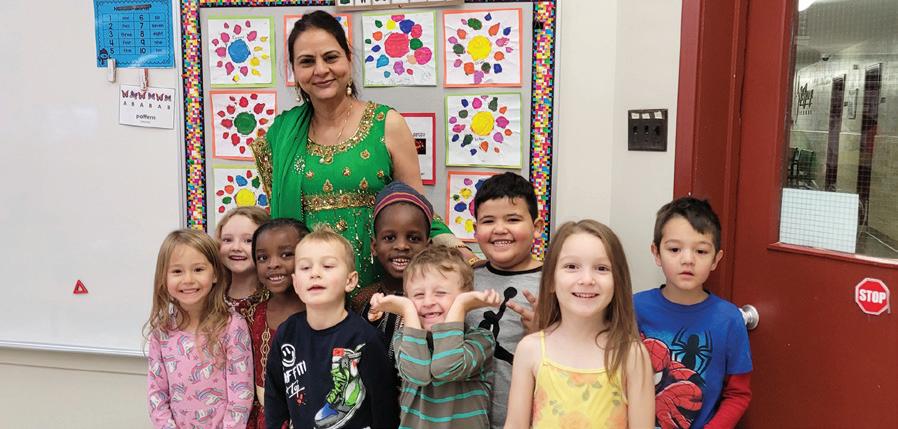
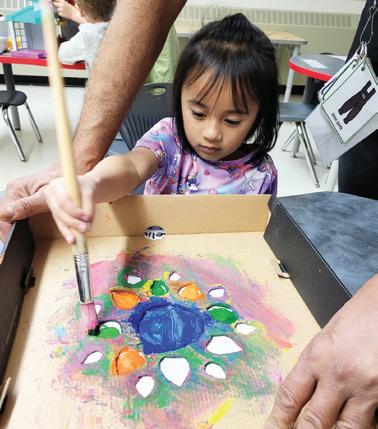
ILLUMINATING DIWALI A CELEBRATION OF LIGHT AND UNITY
By Ripudaman Sidhu
Diwali, also known as the Festival of Lights, holds a significant place in Hindu culture, symbolizing the victory of light over darkness, good over evil, and knowledge over ignorance.
One of the most popular legends associated with Diwali is the return of Lord Rama, along with his wife Sita and brother Lakshmana, to their kingdom of Ayodhya after 14 years of exile and defeating the demon king Ravana. The citizens of Ayodhya welcomed them by lighting rows of lamps, symbolizing the triumph of good over evil.
DIWALI AT ST. GEORGE SCHOOL
At St. George School, the celebration of Diwali was a vibrant and joyous affair that brought together students and staff in a spirit of unity and festivity.
Throughout the week, students participated in various activities and crafts, showcasing their creativity and gaining a deeper understanding of Diwali's cultural significance.
The early years and 3/4 classes
decorated diyas and created rangoli art with paint, while students aged five to eight participated in henna art workshops held over the lunch hour.
Across all grades, teachers read books about Diwali, watched Diwali celebrations on YouTube videos, learned greetings in Punjabi and Hindi, and decorated the hallways with Diwali artwork.
On November 6, 2023, we celebrated Diwali, with the entire school joining a morning assembly via Teams.
The event began with a special introduction to Diwali, where the significance of the festival was explained, and students were encouraged to embrace its message of light and positivity.
I read a book about Diwali in English, and my students translated it into Urdu, Hindi, and Punjabi. With the assistance of a colleague, I had identified students who could speak
Urdu, Hindi, and Punjabi to participate in the celebration ahead of time. This was a proud moment for everyone involved, and parents were grateful for the opportunity.
Some colleagues and I brought East Indian sweets for the staff to enjoy.
To this day, my students fondly remember our cultural celebration of Diwali. The celebration was a wonderful blend of tradition, culture, and community spirit, highlighting the school's commitment to embracing diversity and fostering a sense of togetherness among its students and staff.
Diwali is not just a festival. It is a celebration of life, light, and unity. It transcends boundaries, bringing people together in a spirit of joy and harmony. Our celebration at St. George School was testament to the true essence behind this special festival.
This year, Diwali will be celebrated on Friday, Nov. 1.
SPRING 2024 | THE MB TEACHER 27
DISRUPTING BUSINESS AS USUAL :
FROM MEME-ENTS OF DESPAIR TO GLITTER AND HOPE
By Kim Cao (they/them)
In the years of current teaching realities, the comic with the dog sitting in a burning room responding with “I am fine, everything is fine” by K.C Green still feels closely relevant. Business as usual responses to mass atrocities; disguising themselves as polite and diplomatic greetings while the million march for children disguises itself as ‘parental rights’ to further unconstitutional anti2SLGBTQIA+ legislation, bearing witness to global violence and trying to navigate collective responsibility to hold ourselves and each other accountable.
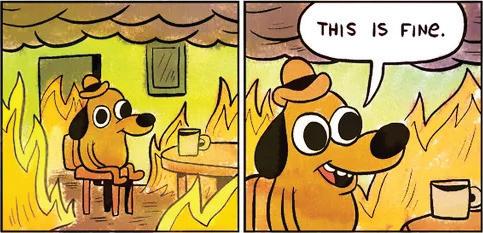
HOW DO WE DISRUPT BUSINESS AS USUAL?
First, we must acknowledge that the room is burning and not trust anyone who says that ‘everything is fine’. These distracted deflections attempt to take us away from the hard realities not everyone can afford to turn the other way.
I offer my positionality as a means to my perspectives on how I move through the world.
PERSONAL BIRTH STORY
I was born feet first, c-sectioned but still in the amniotic sack. The running joke would be that, since before I was even born, I was already hard-headed and stubborn. Later in life, a nurse
once told me that according to folklore, I am seen as a lucky, un-drownable mermaid baby, half human, half mythical creature. Maybe this is why my parents were able to survive the war and cross oceans. Unbeknownst to me, my veiled birth story is a small piece of a continued liminal journey propelling me forward.
As a child, I grew up on what some folx would say as ‘the wrong side of the tracks’ in Winnipeg’s North End. Having grown up, I was conditioned to feel shame for the stigma associated with the socio-economic status of my postal code, as well as having illiterate parents who were not able to be involved with my schooling as they tried to ‘assimilate’ into so-called Canada. Given these circumstances, I learned to shrink myself, and dared not to dream.
As such, my positionality as a racialized settler drives my commitment to address the urgent need for inclusive, anti-oppressive pedagogy and intersectional curriculum design.
DISRUPTING BUSINESS AS USUAL
If we want to have difficult conversations and disrupt business as usual, we must look to examine how 2SQTBIPOC+ youth are denied their humanity. How are 2SQTBIPOC+ made in/visible in schools? How are they silenced and erased? When they do speak up and take up space, how is it received? Without safer spaces where 2SQTBIPOC+ youth can gather and feel like they can relate to and see themselves in, the lack of representation will further stigmatize their identity and hinder their full potential.
Egale released Still in Every Class and School report in 2011 and while there have been some improvements since then the 2021 report states that “79% of reported physical harassment is ineffectually addressed by school administration”. High schools can be violent spaces for queer, trans, twospirit, Black, Indigenous and racialized youth (2SQTBIPOC+) but schools can
28 THE MB TEACHER | SPRING 2024
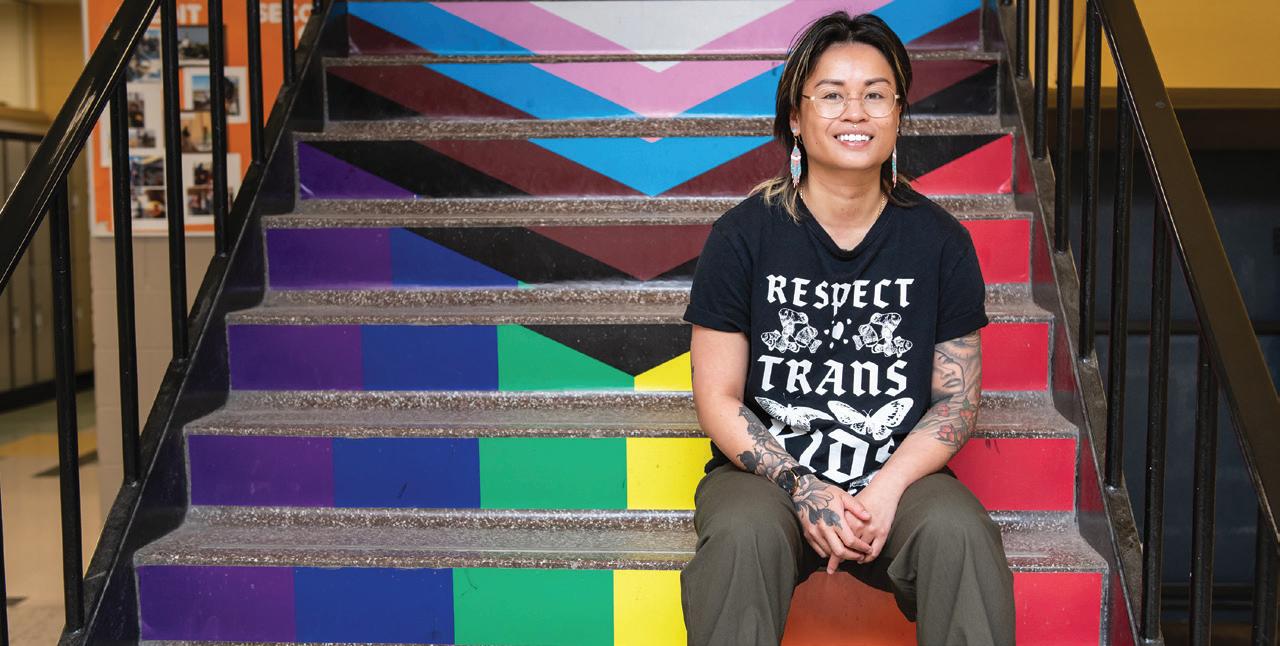
also be places where they find safety especially with their teachers, mentors and peers.
Further, the insidious ways in which institutions replicate the tools of the oppressor is to speak of 2SQTBIPOC+ as deficit, as Other, as margins that need the acceptance from the status quo as ‘normal’, as binary, as an acceptable queer and/or racialized person that will tow the line.
Bridging the gaps between displacement and connection is crucial for fostering a more equitable and just learning environment, especially for 2SQTBIPOC+ youth facing multiple intersectional barriers whether its with racism, classism, disabilities, and/or queer & transphobia.
Knowing this, it is critical to support and celebrate 2SQTBIPOC youth, especially with current hostile political climate where anti-2SQTBIPOC+ rhetoric and legislation are amplified. Creating space where 2SQTBIPOC+ youth can re/narrate their stories, have the capacity for agency to build community, in addition to unlearning
internalized shame and feel supported is suicide prevention.
ACTION NEXT STEPS
In no particular order:
1. Learn to de-center hegemonic ways of knowing and do the work of learning what that is.
2. The collective response to systemic inequities and violence must be invested in community and mutual aid. We need to take care of each other by being active accomplices; show up to your local gathering, mutually contribute to community needs, offer people your positionality & pronouns when possible.
3. Take time to learn and understand that 2SQTBIPOC+ are not a monolith.
4. Audit your course syllabus and teaching materials.
A. Whose voices are you highlighting? Who is still left out? How can you include diverse writers and authors without tokenizing 2SQTBIPOC+ voices?
B. When you are including 2SQTBIPOC+ narratives, be mindful to not just show marginalized peoples as dead bodies, as criminals, as ‘Other’. C. How will we design our classrooms, hallways & schools where all students dare to dream?
5. If you are part of the 2SQTBIPOC+ community, I hope you find joy in the small things and know that even when it feels like a lonesome and frustrating journey of ‘doing the work’, there are many of us who have your back. Reach out when you can.
Disrupting business as usual asks for honest responses to everyday responses of, “how are you?” and instead of an autopilot response of ‘I’m good’, instead let us look to the meme of the glittery hamster in a convertible with sunglasses (Snazzyseagull) and reply with the hopeful and energy of “The horrors persist, but so do I”.
SPRING 2024 | THE MB TEACHER 29
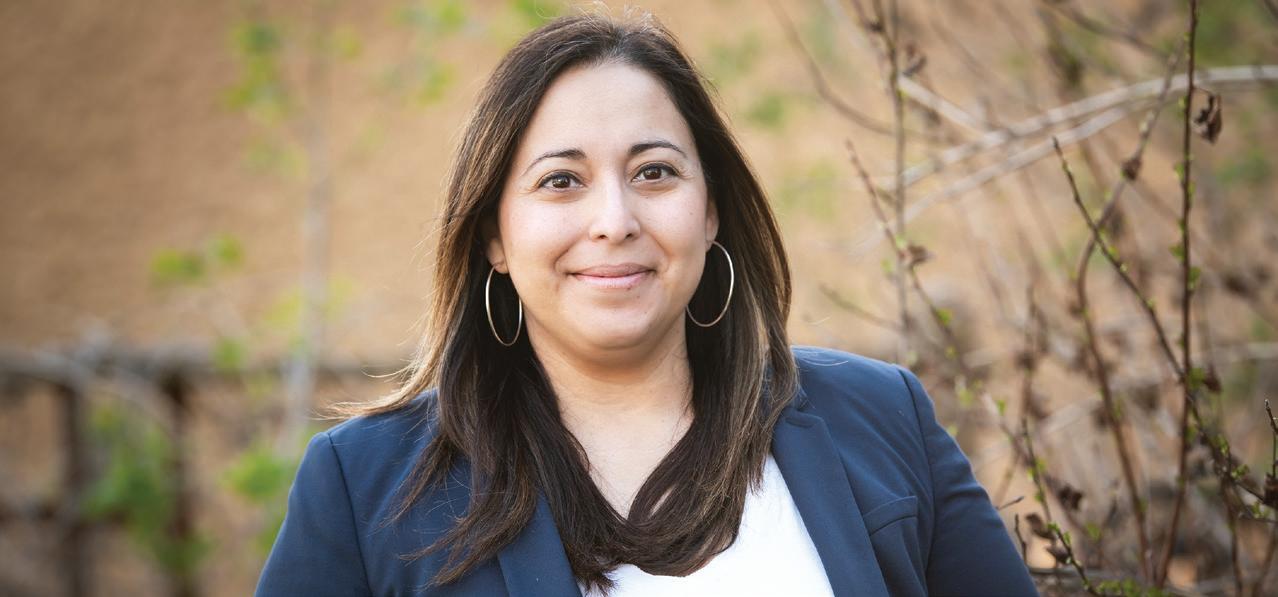
THE JOURNEY FROM IDENTITY STRUGGLE TO UNION LEADERSHIP
By Marcela Cabezas
One of the difficulties of being a first-generation Canadian is neither completely belonging here nor in your parents’ homeland. This feeling of not-belonging is often reinforced by white people asking, “So, where are you from?” followed by the surprised expression when you say you were born in Winnipeg.
One of the difficulties of being a firstgeneration Canadian is neither completely belonging here nor in your parents’ homeland. This feeling of not-belonging is often reinforced by white people asking, “So, where are you from?” followed by the surprised expression when you say you were born in Winnipeg.
Growing up in Winnipeg’s south end, there were never more than a handful of Latinos at my school. On the one hand, I never had to navigate the problem of sharing a classroom
with the numerous Jennifers, Chrises, or Mikes. I was the one and only Marcela throughout my entire K-12 school journey. On the other hand, my challenge was having to constantly correct the spelling and pronunciation of both my first and last name. My last name was too ethnic for others to commit to memory accurately, and my first name was consistently anglicized with an extra L.
During middle school I experimented with going by the name Marcie, but by high school
I had reverted to Marcela. The lasting impact of this experience is a heightened sensitivity to the importance of correctly addressing names, especially those of my own students.
Throughout my K-12 school journey, I can vividly remember having only one teacher who wasn't white. The curriculum, unfortunately, didn't do much better in reflecting my identity.
Despite this, my favorite subjects—social studies, history and French—served as beacons of connection. Social studies and
30 THE MB TEACHER | SPRING 2024
history provided a rare opportunity for me to delve into and connect with my Latin American roots, while the cadence of the French language closely echoed my mother tongue, Spanish.
Spanish was the first language I spoke, but I was never formally taught how to read or write it. In fact, for many years I had stopped speaking Spanish with my parents after being made fun of by classmates for speaking it in front of them. However, a turning point occurred in Grade 11 when my high school introduced Spanish courses. The opportunity to learn my mother tongue in a formal setting reignited a dormant sense of pride in my cultural heritage.
Two decades later, I have had the privilege of sharing the love of my language and culture with hundreds of students.
For most of my teaching career, I was among a small group of IBPOC staff in a school characterized by a similarly homogeneous student population. In those early years, navigating incidents of microaggression or blatant racism were difficult and emotionally draining.
It's challenging for others to grasp the impact of such situations when it's not their lived experience. Consequently, explaining to colleagues why a seemingly insignificant incident was significant to me added to the sense of exhaustion and isolation.
Nowadays, divisional policies exist to ensure that appropriate action is taken promptly and with supportive measures. But policies are only as good as the training to support their proper implementation.
Over the last five years, a significant shift in the diversity of the student body at my school has taken place. I no longer experience the same degree of isolation as a person of color navigating the school hallways. However, in this evolved environment, I now carry a heightened sense of responsibility to amplify the concerns of individuals from equity-seeking groups.
As the daughter of a Mexican immigrant and a Chilean political refugee, I was raised on a steady diet of social justice and politics. It is this foundation of values, instilled in me by my parents, which drew me to union work.
Only four years into my career, I took the initiative to run for a member at large position on the Louis Riel Teachers' Association (LRTA) executive. My aim was
to magnify the voice of young teachers in the decision-making process. As my understanding of my identity and the impact of my intersectionality has sharpened, my advocacy has naturally evolved.
Fast forward eight more years, and I was teaching in the mornings and working in the LRTA office in the afternoons in my role of Vice President of Professional Development. Balancing these responsibilities alongside a young family was undoubtedly challenging. However, it was crucial to undertake this juggling act, as it was important to show young and aspiring women leaders that motherhood didn't have to mean the end of their involvement with the union.
During this same period, MTS established the Women in Educational Leadership Commission (WELCOM), marking the Society's first-ever commission dedicated to examining the significance of women assuming formal and informal leadership roles. WELCOM's mandate also included identifying barriers or challenges faced by women in pursuing or serving as leaders and developing strategies to support women within MTS, Locals, and their school divisions.
As one of the three commissioners appointed to WELCOM, it was both an honour and privilege to engage in this work and present numerous recommendations that have resulted in tangible changes within the organization, impacting both the Society and local levels. Equally noteworthy is that WELCOM and its many recommendations laid the groundwork for other equity-seeking groups, such as the 2SLGBTQIA+ Ad-hoc Committee, to carry out their initiatives. This groundwork included the establishment of symposia and networks for the 2SLGBTQIA+ and IBPOC communities.
With a decade and a half spent at leadership tables within my local union and eventually with MTS, fostering the development of future leaders has consistently held great significance for me. As teachers, we inherently possess leadership qualities. Yet, we often confine our understanding of leadership to roles within school and school board offices, limiting ourselves to either pursuing a prescribed path to these positions or dismissing them entirely because they may not immediately appeal to us. Nevertheless, leadership in public education can manifest in many forms.
My educational leadership journey was not school based. Rather, it was rooted in union work.
Like my experience as a student, the representation of individuals who shared my background was sparse among those seated with me at union leadership tables. Throughout my four-year tenure as president of LRTA, it was a rarity to find other people of color at Presidents' Council meetings or at the Provincial Executive table.
It is doubtful that anyone who is white has ever had to contend with the perception of others, real or implied, that the sole reason they were present at tables of influence was because of their race.
Battling imposter syndrome is real and daunting, particularly in moments when I was made to feel like the sole reason I was invited to take part was because of the diversity boxes I checked. Having to prove to others and at times to yourself that you are there because of your own merits is arduous. There were certainly moments I wished for more folks like me to be involved in the work so that it didn’t feel so onerous and burdensome.
When it comes to MTS, there are many doorways that lead our members into the heart of the organization. For some it is political activism to protect the rights and working conditions of our colleagues, for others it is equity and social justice work to build better futures throughout the public education system. And in some cases, it is to help create professional learning opportunities for our colleagues to help us better understand each other and better meet the needs of our students and school communities.
I believe that diversifying our leadership is the key to unlocking new voices and varied lived experiences, which in turn broaden our perspectives. By embracing this diversity, we not only open minds and hearts but also discover innovative ways to fortify our organization and support our members. There are many seats at many MTS tables that are waiting for members of equity seeking groups to join them. When more IBPOC members find the point of entry into MTS that makes the most sense to them, those spaces will become braver and more enriched by their presence and involvement.
SPRING 2024 | THE MB TEACHER 31
EMBRACING IDENTITY:
NAVIGATING IMPOSTER SYNDROME AND CELEBRATING MÉTIS HERITAGE
By Kerri Keffer

There is a beautiful little town that lies outside the south of the Perimeter called St. Norbert. It is famous for its farmers’ market, the plays that would take place at the Trappist Monastery Ruins and the Red River Floodway (just outside of town). Growing up in this beautiful place, my friends and I would fish along the La Salle River, ride our bikes to LaBarriere Park and pretend to be married at the church down the street from the high school.
What I did not know is that all the places where we chose to visit and hang out were filled with much more meaning, importance, and history than what we were taught.
UNCOVERING LAYERS OF MEANING IN ST. NORBERT’S LANDMARKS
I have stood in the place where my ancestors fought for the rights of the Red River Métis people, I fished near the banks on which Louis Riel evaded capture during the resistance. As a child, I was “married” in front of the church built to commemorate the creation of Manitoba. I walked the streets named after my ancestors (who are one of the founding families of St. Norbert) and other influential Red River Métis citizens. This lack of education and understanding about who I was, and the positive teachings of my culture left me feeling like an imposter. I felt like I did not belong in a place that I called home.
CONFRONTING IMPOSTER SYNDROME
Imposter syndrome is a term I know well. In fact, I would say that we were and still can be best friends from time to time.
If I was to define imposter syndrome, I would say it is a feeling - a feeling like you are a stranger to yourself. It’s a feeling like you are a fraud and that at any moment someone is going to call you out by asking questions that you cannot answer because you do not know the facts.
The inability to respond with concrete facts would prove that you are an imposter.
I felt proud to say I was German, English and French with roots in Prussia, Belgium, France, Gladstone, St. Boniface, and even Kerry the German settlement in St. Labre, Manitoba.
Every now and then I would take a risk and say that I was Métis. I would gauge the reactions of the listeners as they processed this idea of identity. While they pondered, I felt like an imposter as soon as the words came out of my mouth.
What did that even mean? How will I be treated?
Let me tell you, the stereotypes that perpetuated around this idea of being Indigenous at the time were scary. I did not know if I had enough knowledge to correct or redirect misinformation because I did not know what that misinformation may be.
What I did know is that the words felt empty, they felt like the wind took them and did not allow for others to hear them and for me to feel the power of them.
Sure, I could show them my genealogy or a picture of my dad. I could say that my grandmother would make a mean bannock on special occasions and that I knew how to bead loom, but in the end that would not be enough.
I did not have the historical context back then to defend anything, especially my Red River Métis heritage. A part of this uncertainty came from my paternal side
32 THE MB TEACHER | SPRING 2024
and hearing stories of family members denying the Métis ancestry and always wondering if we were not Métis, why did my father, my brothers, and I have our Métis citizenship cards? The narrative about being Indigenous was not a positive one growing up. The “reign of terror” and racism can take credit for that one.
EMBRACING MÉTIS IDENTITY
I can now say with pride that I am a proud Red River Métis woman who has attended sweat lodge ceremonies, smudges, carries teachings, can bead and make moccasins and gauntlets.
I can make a ribbon skirt and I am uncovering my history and will continue to learn about my ancestry.
I walk in two worlds. I am Métis. I carry the blood memory of my First Nations ancestors and have lived in the world of my European ones. I find strength in knowing that I can and have been building the bridge between two worldviews that I never even thought would complement each other.
My culture came from two beautiful cultures that found a way to build upon each other’s strengths, to grow and adapt in a way that created another culture using the entities of two.
I always felt connected to First Nation teachings that I was introduced to in university. I trust my knowledge and continue to grow. I find peace with the trees and within the animals of the seven teachings. My kids will be the ones who will never know what it is like to not know where you come from. They are proud to be Métis and they are proud to speak about how they are Indigenous, to wear their Métis sashes and have the chance to learn Michif and French.
History and systemic racism tried to take my ancestry away from me. It tried to make me ashamed, and it tried to disguise me.
I have fought back, and I have come to find that there is strength in being a Red River Métis woman. I am of the “found” generation. I have been given the opportunity to witness the eight fire and walk with people who are no longer okay with Indigenous history being ignored or cast to the shadows.
I am bridging the disconnect of culture back to my father and raising my children to know who they are and where all their ancestors came from.
My story is like so many other stories in Manitoba. I do not have to choose which side of my ancestry holds my only teachings. I cherish the way I was brought up and I am now finding that my identity is not so hollow, I am not so lost.
Education helped me start my journey, education helped me discover avenues to search for answers and connections, education allowed me to experience ceremony and teachings that I would have never found until maybe more recently. Education has given me the opportunity to educate others and to help fill in the gaps with my own family. The eighth fire has been lit and with that, education is going to bring back history and shine the light on the hidden curriculum.
THE PATH FOWARD
Last year, I was asked to speak at a Manitoba Rural Learning Consortium (MRLC) session that was focused on the Mamàhtawisiwin: The Wonder We Are Born With framework. My best friend, Imposter Syndrome, was right there with me but I did not let it deter me. Rather, I let it remind me of my journey and how far I have come. With that I decided to create a list of sayings that I have used successfully along my journey, ones that I must remind myself of often:
1. Lean into the discomfort. It is okay to feel uncomfortable, this is how we know that we are learning and that we are human. Let your students know that you may be learning with them. Go on the learning journey with them; be transparent.
2. Walk in a good way/teach with good intent.
If your intentions are that of education, learning, and including perspectives that are not necessarily within the textbook, etc., then you are well on your way. If you make a mistake or speak of some misinformation, correct it and let them know that you are correcting it. When you can, ask for guidance from a coworker, Indigenous Elder or Knowledge Keeper, or start making some phone calls. To walk in a good way is learning from your mistakes.
3. The power of “why”. You will not believe what happens when you ask a person “why”. This
creates a conversation and a chance to understand why someone feels the way they do or thinks the way they do. It is always about questioning the content or perspective, not the person (if you say that, the defenses go down almost immediately).
4. You cannot force people to check themselves. It is difficult to check one’s bias and this cannot be forced. Individuals need to go through a grieving process when it comes to ways of their beliefs, way of thinking, and even the stereotypes they have. The world is changing quickly (even if it does not feel that way). People need time to change, to process what they thought to be true and realize that they may not have all the information.
5. Just ask.
This is one that I must remind myself so often about. Just ask, if they say “no”, that is okay. If they say “yes”, even better.
6. Reconciliation is not a race. Reconciliation is about relationship building, and as we know, relationships take a lot of work and a lot of time. If your intentions are not about relationship building and simply about checking off the box, then you will probably find out quickly that things may not go as planned and that the journey will become increasingly difficult and frustrating. Take a breath and the time for this work will always be available.
7. Doing nothing is not an option. This one is self-explanatory. We can do better, and we should be doing better. It does not matter the demographic of your school, or the area in which you teach. Start small, start with something that you know a little about or that a coworker or perhaps friend or family member may know something about. The reality is, preparing our students for the “real” world, is preparing our students with true history and ways of engaging and building relationships that are healthy.
SPRING 2024 | THE MB TEACHER 33
UNE RÉFLEXION SUR L’IMPORTANCE DE LA REPRÉSENTATION
Par Christopher Afatsawo et Jean-Louis Péhé
Qu’y a-t-il de mal si on parle de l’équité et de justice sociale?
Il nous semble qu'à chaque instant que des conversations autour de l'équité et de justice sociale refassent surface, surtout dans nos écoles, il faut absolument jouer avec beaucoup de prudence. Des théories, des livres, des recherches et des discours qui cherchent à cerner un thème particulier frôlant l'équité et la justice sociale, piquent au vif les débats. Ce que nous cherchons à faire dans cette conversation, c’est d’explorer la liminalité entre les deux causes: celles qui défendent les vagues de changements et celles qui ne résistent pas nécessairement aux changements mais sont réticentes. Naviguer la liminalité entre les deux causes mérite de mûres réflexions.
Il n’a jamais été question d’anonymat quant aux questions du racisme, ni de discrimination systémique à tous les niveaux. De la même manière, l'équité et la justice sociale planent sur nos quotidiens qu’ils soient perceptibles ou non. Nous voulons, comme point de départ, mettre l’emphase sur l’impact de ces conversations sur notre profession en tant qu’enseignant.e.s dans les écoles canadiennes. Le terrain est vaste et nous n’avons jamais la prétention ridicule d’avoir tout vécu, car il est plus facile de dénoncer un ordre social injuste que d’en formuler un qui soit juste.
Tout d’abord, nous voulons signaler à nos lecteurs que nous, les auteurs de ce reportage, n’avons pas vécu de telle
IL N’A
JAMAIS
ÉTÉ QUESTION
D’ANONYMAT QUANT
AUX QUESTIONS
DU RACISME, NI DE
DISCRIMINATION
SYSTÉMIQUE À TOUS
LES NIVEAUX. DE LA MÊME MANIÈRE,
L'ÉQUITÉ ET LA JUSTICE
SOCIALE PLANENT SUR
NOS QUOTIDIENS QU’ILS
SOIENT PERCEPTIBLES OU NON.
discrimination ni du racisme « strictus sensus » dans nos écoles respectives; une situation rare dans tous les sens. Lorsque nous avons lancé un appel à certains collègues (tous et toutes sont des personnes d’origines noires) de partager leurs expériences dans le cadre de l’enseignement, nombreux étaient celles et ceux qui se sont portés volontaires car ils
étaient tour à tour, selon eux, marqués par une série d'événements. Ainsi, ils brûlaient d’envie et voulaient partager leurs soucis. Nous étions à l'écoute fidèlement, nous deux, à leurs doléances. Même si certaines conversations semblent sombres, nous disons que ne pas en parler n’est pas une option.
L’INTERVENANT 1
Notre tout premier intervenant œuvre dans une école secondaire ici au Manitoba. Ambitieux comme il est, ce dernier a voulu suivre un seul cours d'été au niveau bac pour se ressourcer en salle de classe. Pour se faire, il a dû s'embarquer à une longue et épineuse démarche à savoir une application auprès d’une université au Manitoba. Pour donner un contexte au processus, il importe de noter que notre intervenant donne des cours d’anglais et de français au niveau secondaire. Notons aussi que notre intervenant détient une maîtrise d’une université canadienne. Pour que l’application soit complète, on lui demande de fournir ses relevés de notes du premier cycle alors qu’il a déjà fourni des copies certifiées de ce dernier, et une copie originale de relevés des notes au niveau de maîtrise, envoyées directement de l'université canadienne où il a décroché sa maîtrise. Chose étrange est que, s’il détient un diplôme d'études secondaires
34 THE MB TEACHER | SPRING 2024

au Canada, son application serait complète et il serait admissible. Par extension, la maîtrise d’une université canadienne était inadéquate par rapport à un diplôme d’études secondaires canadien. Il est évident que l'éducation et la volonté de s’ouvrir à des perceptions différentes avec la moindre flexibilité est limitée.
L’INTERVENANT 2
Notre deuxième intervenante pense qu’actuellement, le paysage démographique dans nos écoles change. Avec le flot d’immigration récent, la composition de nos salles de classes change aussi. La diversité culturelle et la mixité sont évidentes et au rendez-vous. Cependant, les cadres enseignants ne riment pas avec cette nouvelle tendance ou réalité. Ainsi, notre intervenante se sent esseulée en tant que membre de sa communauté scolaire. Elle est de l’avis que les cadres enseignants doivent nécessairement être plus représentatifs.
L’INTERVENANTE 3
Notre troisième intervenante est enseignante depuis quelques années dans une école primaire au rural. Bien que nouvelle dans cette école, elle se sent bien accueillie et acceptée par ses élèves et les parents des élèves avec qui elle a une bonne relation. Certains de ses collègues semblent
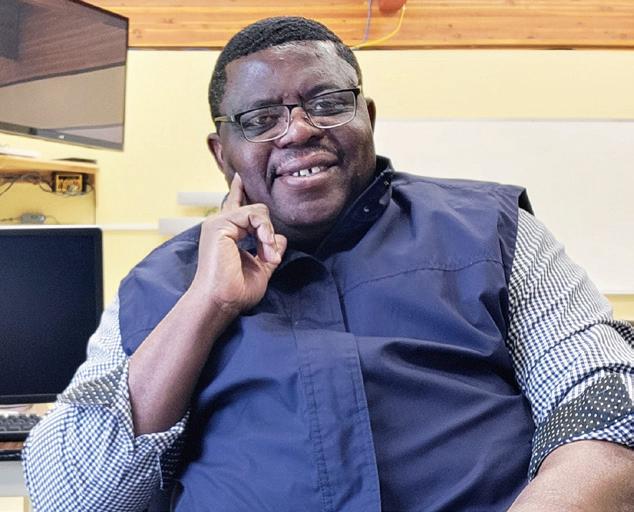
bien l’accepter aussi et fournissent des efforts pour l’intégrer dans le groupe. Elle est très enthousiaste à participer dans la vie scolaire de son école et le fait savoir d’ailleurs à ses collègues enseignants. Le hic, ce sont certains membres du personnel qui par des micro-agressions (certainement guidés par leurs propres biais) ont mis l’enseignante dans l’embarras et l’inconfort. Cela pouvait partir des choses toutes simples (refuser de partager un repas à la même table; des auxiliaires qui se mettaient avec des élèves pour se moquer de son accent, etc..). Cependant, cette enseignante garde espoir optimiste que les choses iront mieux dans un futur proche.
L’INTERVENANTE 4
Notre dernier intervenant est un enseignant homosexuel et noir, dans une école primaire de la ville. Accepté par ses collègues enseignants. Il fait partie d’un personnel enseignant accueillant et courtois. Pour lui, ce qui est important, c’est d’effectuer son travail en se préoccupant de la réussite de ses élèves. Il montre le même enthousiasme envers les parents d’élèves. En revanche, certains parents de la classe de maternelle ne sont pas à l’aise avec cet enseignant dans la classe de leur enfant. Ils n’ont pas confiance. Et ils ne manquent pas une occasion de le faire savoir à notre intervenant. Il le vit mal, mais garde son calme. Sa direction ne le
soutient pas vraiment, préférant le laisser seul s’expliquer avec les parents. Ses méthodes pédagogiques sont remises en cause par ses parents d’élèves. Chaque jour, c’est un courriel condescendant d’un parent qu’il reçoit et qu’il traite avec professionnalisme.
LA QUESTION DE LIMINALITÉ
Notre dernier intervenant est un enseignant homosexuel et noir, dans une école primaire de la ville. Accepté par ses collègues enseignants. Il fait partie d’un personnel enseignant accueillant et courtois. Pour lui, ce qui est important, c’est d’effectuer son travail en se préoccupant de la réussite de ses élèves. Il montre le même enthousiasme envers les parents d’élèves. En revanche, certains parents de la classe de maternelle ne sont pas à l’aise avec cet enseignant dans la classe de leur enfant. Ils n’ont pas confiance. Et ils ne manquent pas une occasion de le faire savoir à notre intervenant. Il le vit mal, mais garde son calme. Sa direction ne le soutient pas vraiment, préférant le laisser seul s’expliquer avec les parents. Ses méthodes pédagogiques sont remises en cause par ses parents d’élèves. Chaque jour, c’est un courriel condescendant d’un parent qu’il reçoit et qu’il traite avec professionnalisme.
Scan the QR code to read this article in English.
SPRING 2024 | THE MB TEACHER 35
Jean-Louis Péhé
Christopher Afatsawo
HONOURING INDIGENOUS PERSPECTIVES AND VALUES FOR TRUE RECONCILIATION
By Claudine Lambert
Reconciliation is a process of healing relationships between Indigenous and non-Indigenous peoples. This process needs to start with our children in early years and elementary schools.
The Canadian education system deprived Indigenous people of their languages, cultures and communities – not only through residential schools but also through school curricula. It is of the utmost importance to reverse this damage by following the Truth and Reconciliation Commission’s 94 Calls to Action . These 94 calls to action are an appeal to all levels of government, organizations and individuals to make concrete changes in society. They list actions to redress the legacy of residential schools and advance the process of reconciliation and – perhaps most importantly – to enrich students by imparting valuable Indigenous ways of knowing.
Every teacher in every classroom works in a school that is physically connected to Turtle Island land so Indigenous history is already a present influence for us. By consciously incorporating Indigenous values into our school systems, we can make education relevant to Indigenous students who are lacking in such knowledge and who are also disproportionately affected by problematic systemic issues.
We can also provide non-Indigenous students with opportunities to learn about valuable Canadian histories and cultures. Because true reconciliation
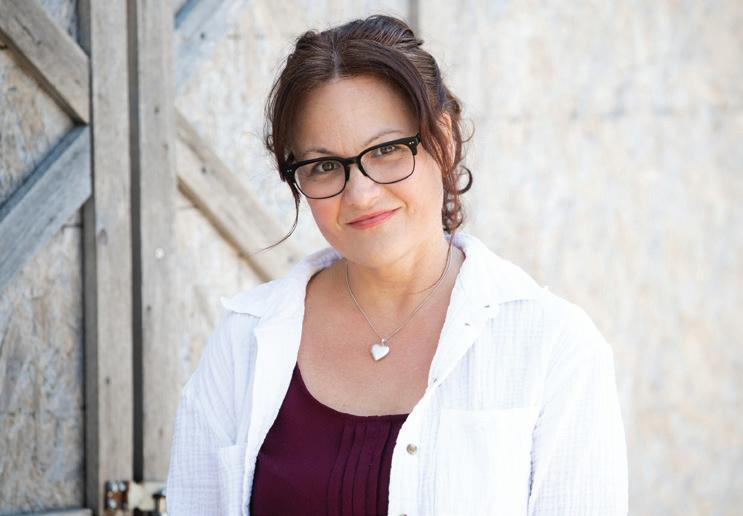
is about relationships and progress. Colonialism has had destructive impacts on Indigenous people’s education, culture and languages. Indigenous people are the original peoples of this country and have Treaty and human rights that must be respected and recognized.
Truly everyone can benefit from the Seven Sacred Teachings of Honesty, Love, Belonging, Truth, Wisdom, Humility and Respect I was taught as
a child. Incorporating these values in the classroom is a powerful means of fostering respectful relationships and of creating culturally diverse and safe spaces for all students.
Teachers play an instrumental role in developing culturally competent communities that help us move forward as a nation. Indigenous practices also incorporate helpful new teaching approaches, such as collaboration,
36 THE MB TEACHER | SPRING 2024
adaptability and difference. It institutes layered concepts, like the importance of language and the geography of stories, land protections and rights, relationality and accountability, a connection to reconciliation, and much more.
RECONCILIATION THROUGH EDUCATION
Reconciliation is a process of healing relationships between Indigenous and non-Indigenous peoples. This process needs to start with our children in early years and elementary schools.
Students must be taught about the history of Indigenous peoples in ways that foster respect and empathy. Students in our schools, throughout Manitoba, must learn about residential schools.
It is crucial that learning about the impact of residential schools, Treaties and Indigenous people’s history and culture are a requirement of the K-12 school system. Curricula must include and respect Indigenous cultures.
Teachers must be trained on how to integrate these teaching methods in their classrooms. All children, but especially our Indigenous children, must have access to learning about their culture and language when possible.
DOING THE WORK FOR RECONCILIATION
My school has well-being assemblies each month where family groups, named after one of the animals from the Seven Sacred Teachings, come together and have a sharing circle that focusses on Honesty, Love, Belonging, Truth, Wisdom, Humility and Respect.
We have decided, as a school, to focus our professional development this year on reconciliation. All staff are engaged in learning about the four seasons of reconciliation through the Outdoor Learning Store and Reconciliation Education.
These online courses and films provide a comprehensive, customized anti-racist education in line with the Truth and Reconciliation Commission’s 94 Calls to Action . The aim is to promote a renewed relationship between Indigenous peoples
STUDENTS MUST BE TAUGHT ABOUT THE HISTORY OF INDIGENOUS PEOPLES IN WAYS THAT FOSTER RESPECT AND EMPATHY. STUDENTS IN OUR SCHOOLS, THROUGHOUT MANITOBA, MUST LEARN ABOUT RESIDENTIAL SCHOOLS.
and Canada through transformative multi-media learning.
Here are some examples of other things we have done in our school to integrate Indigenous history and teaching methods in our classrooms:
1. During the week of Orange Shirt Day, we do daily activities such as watching the video from Phyllis Webstad who went to residential school and wrote the book entitled Orange Shirt Day and tying orange ribbons around our school fence that say, “Every Child Matters”.
2. We have coloured orange shirts and talk about the significance of Orange Shirt Day. We are not simply wearing orange. We are wearing orange to show support to the residential school survivors who had their culture and language taken away from them.
3. We have Elders and Knowledge Keepers coming into our school to teach about reconciliation and culture.
4. We have put up a tipi where we have students take part in drumming with an Elder.
5. We have tied safety pins with beads onto our shoes with the four colours of the medicine wheel.
6. We have a Pow Wow Group coming to teach our students how to dance.
7. We have had Métis musicians play fiddle music for our students while we dance the jig.
8. We have had a Métis Elder teach our students the red river jig and spoons, and how to make bannock.
9. We have had Indigenous authors and illustrators come to read to our students during I Love to Read Month.
10. We have purchased many books in our library and classrooms related to Indigenous culture and knowledge.
11. Our Grade 2 students have developed their own land acknowledgement that is read before each assembly and school concert or event.
I know that some schools offer smudging ceremonies to their students. My cousin is currently a teacher and does this daily with her Grade 5/6 classroom in Winnipeg. Some classrooms have made dream catchers and drums with their students. This list barely scratches the surface. Sky is the limit!
LOOKING AHEAD
We need to close the gaps that exist between Indigenous and non-Indigenous Canadians. A goal in high school, for our Indigenous students, is to focus on more success rates in hopes that they will obtain as much success in education as non-Indigenous youth. This will lead to finishing high school and obtaining sustainable employment for the future.
Funding must be continued for Knowledge Keepers and Elders to enter our schools so Indigenous languages can be protected.
We all share responsibility for maintaining respectful relationships with each other.
The understandings of Indigenous culture and perspectives will help with long term reconciliation, and we need to continue having these discussions and teachings in our classrooms every day.
SPRING 2024 | THE MB TEACHER 37
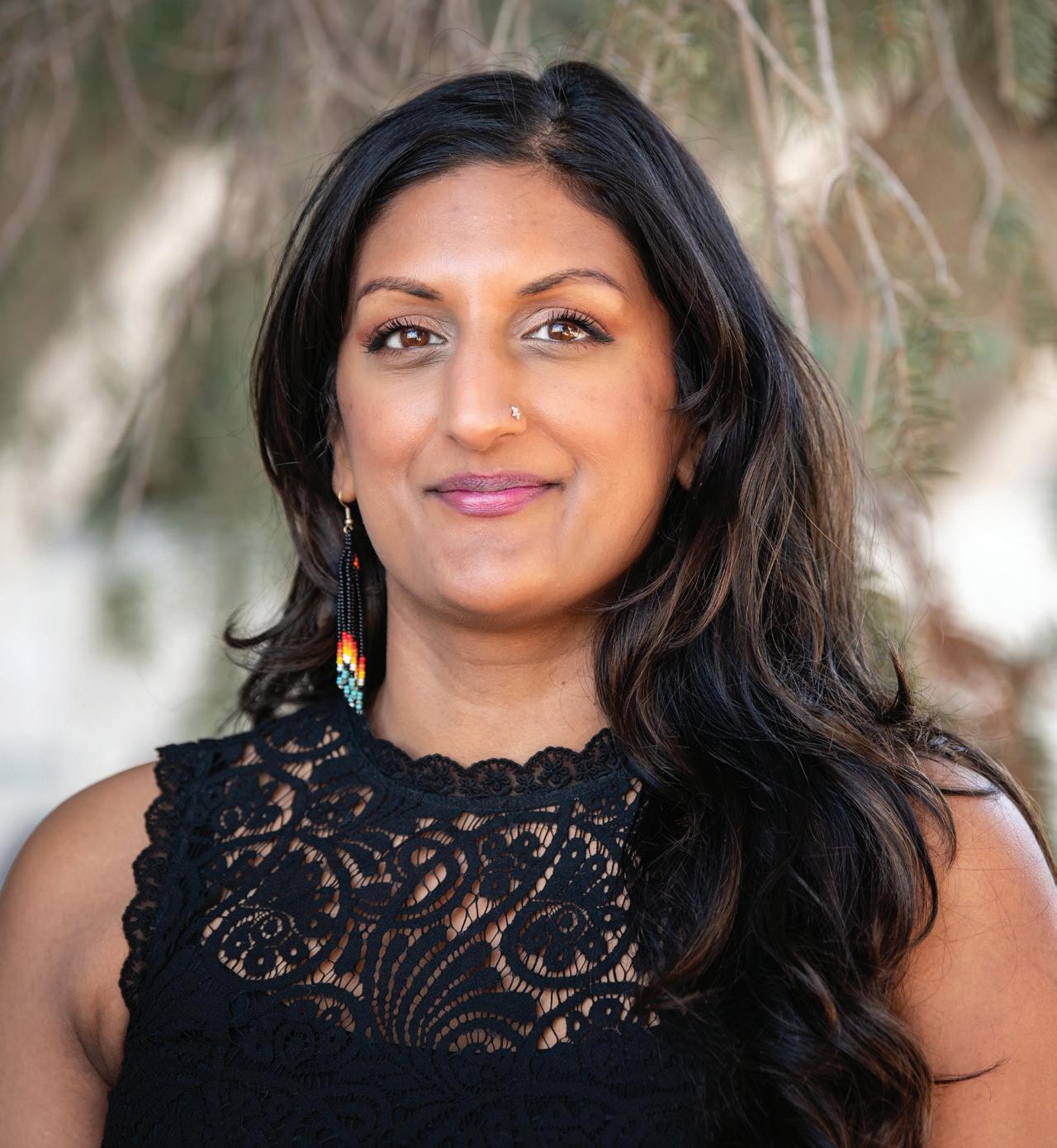
38 THE MB TEACHER | SPRING 2024
RACIALIZED AND TOKENIZED: THE MINORITY REPORT
By Maneesha Manuel
Education is the engine for change. It tirelessly works on all cylinders to keep up with society's constantly ever-changing pressures and demands. For racialized educators in Manitoba, the external forces exerted in the opposing direction create drag and tension and further dissonance in the vehicle for change.
As a racialized Canadian-born woman and educator of 14 years, I normalized the additional overt and covert pressures faced under divisional and school leadership that did not reflect our global and student demographic. Watching colleagues move into positions of leadership or areas of specialization with little to no experience just because they had the privilege of being white became all too commonplace for me, this was especially true in rural Manitoba. However, within the city limits, I'd again find myself tokenized and feeling tension and competition with those who were supposed to unite with me...other racialized individuals. This is lateral violence at work.
You see, this is the minority report— the game. With so little representation in leadership in Manitoba Education, we are conditioned to feel colonized, we will always feel trapped. Even with incremental change in the right direction, an individual who identifies as racialized who is put into positions of leadership becomes tokenized due to the competition within. We end up silencing the covert and overt ways preferential treatment exists because we risk forfeiting our position and value in the workplace. We are seen as a “stick in the mud”, “insubordinate”, “confrontational”, or “the angry brown/black/Indigenous person”.
This isn’t about me, this is about our
WITH SO LITTLE
REPRESENTATION IN LEADERSHIP
IN MANITOBA EDUCATION, WE ARE CONDITIONED TO FEEL COLONIZED, WE WILL ALWAYS FEEL TRAPPED.
students. In order for us to effectively combat systemic and structural racism in education, our leadership and senior administration should reflect the people it serves. In an effort to continue pouring into my career and my students, I diffused my skills and abilities into the background when my contributions were overlooked or my ideas were passed on as someone else’s. This was being an educator—burn out along with putting students first at the risk and cost of what? Work/life balance— this cost me a lot. Research suggests that new teachers will burn out and leave the profession within the first five years of teaching, and this could be even more challenging for racialized individuals. When tokenized as an educator, we learn to walk in the same direction as everyone else, we become accepted into the social norms, discussions, and teams that exist to support other educators and students in creating a better future. And this is wonderful. However, we also learn to keep silent on the injustices we face both in and
outside of the classroom because speaking up puts a target on our backs, one in which is difficult to pinpoint or explain to everyone.
Racialized educators in predominantly white communities either take on being tokenized and assimilated or become the target for lateral competition. Either way, it becomes the universal narrative...when you know, you know. Yes, we’re starting to see change in small increments, but it’s not good enough. I reflect on my educational experience; local, rural, and International, and am proud of my accomplishments and achievements, but disappointed that I have allowed the “system” to dictate my worth and value.
However, not all is lost. My current and former students will always be the driving force behind why I do what I do because I believe in a better future for them. And they deserve it. In my 14 years of teaching, I have met tremendous and wonderful allies; friends who have become like family, fellow educators, support staff, professors, and leaders from around the province and world who have listened, extended their hands, and tried to understand the divide that is systemic and structural racism within our education system, which ultimately affects our students and communities.
These individuals understand that “working hard” and “proving yourself” mean something totally different for the racialized individual. These allies; my friends, have taken notice and understood that all teachers, no matter race, gender, background, culture, religion, ethnicity, or creed, deserve value and equality in public and private education systems.
Now, let’s get to work.
SPRING 2024 | THE MB TEACHER 39
BREAKING THE ICE: INTRODUCING
HOCKEY TO NEWCOMERS
By Roby Yeung
I am not a professional hockey player, nor have I even played at a high level of ice hockey. Heck, the highest level of organized hockey I’ve played was when I was 12, on an A2/A3 community house team. But there is something about the sport of ice hockey that solidifies my Canadian identity. So how did an immigrant from Hong Kong share this passion for ice hockey by bringing ice hockey to a group of new skaters from all over the world?
DISCOVERING HOCKEY IN A NEW LAND
My story of ice hockey started when my family immigrated to Canada from Hong Kong in 1988. I was seven years old. Without knowing how to speak any English, like many newcomer students in our classrooms, I did my best to be part of the school community. Whether playing soccer hockey (where we kicked a puck around) during recess with my classmates over the winter months, or playing street hockey in the summer, hockey was intriguing to this new immigrant.
After a couple of winters in Winnipeg, it wasn’t difficult to be introduced to the game. Some of my friends would invite me to the local community rink to play. But without skates, a stick, or the fancy equipment that’s needed to play, I simply went to the rink to watch them play. Ice hockey is a tough and expensive sport for a newcomer. Not only do you need the necessary equipment, but knowing how to skate is essential to ice hockey.
Most of my friends had already been skating for five or six years before I started learning the sport. It wasn’t until the age of 10 when I fully took the plunge and had my dad register me for the local community team.
At the time when I started hockey, there wasn’t a lot of representation that excelled at the sport. There weren’t any “big name” Asian hockey players in the NHL back in the
MY JOURNEY AND STORY WITH ICE HOCKEY, DESPITE NOT BEING A PROFESSIONAL PLAYER OR STARTING AT A YOUNG AGE, ENCAPSULATES MY CANADIAN IDENTITY.
90s, and seeing someone that looked like you as a coach or teammate was rare. Perhaps, this was my primary reason in promoting and sharing my passion for the game hockey to newcomer students. I wanted them to see how hockey can be played by someone new to the country, and also more importantly, someone who understands the struggles of learning the game as a racialized person.
BUILDING COMMUNITY THROUGH HOCKEY
The idea of introducing ice hockey and skating at our school started over four years ago. Nelson McIntyre Collegiate has three separate weeks called “Weeks Without Walls” dedicated for students to explore careers and experiences that are beyond the curriculum. With an increasing population of newcomers, and students who may never have had the opportunity to play ice hockey, my colleague Chris Enns and I proposed the idea of ice hockey for one of the weeks. Without realizing the magnitude of the challenges ahead, we took it in full stride.
Our first and the biggest challenge was equipment. We had zero equipment to fit a
group of at least 15 students. We searched Kijiji, Facebook marketplace, and asked around for donations for our group and with the generosity of Winnipeggers, we were able to get 18 bags of both new and old equipment. Some of the equipment may have seen better days, but the fact that we were able to get so many sets of full equipment to carry out our week was remarkable. We had 18 students sign up with many of them being on skates for the first time and another 18 signed up (with a waiting list) after a three-year hiatus due to COVID. The students would start the first day learning about the history and the significance of hockey in Canada, then suit up in full hockey gear.
As many of the students are newcomers not only to the sport but the country, I often ask them where they are from when they are on the ice, and when they say “Uganda”, “Nigeria” or wherever their country of origin may be, I would reply, “Think about your family and friends back home, and think about how you can tell them that you are skating on ice and learning how to play ice hockey in Canada!”. This often brought a huge smile and a sense of pride that the students are slowly adapting, immersing, and becoming a regular Canadian citizen, not just another newcomer.
My journey and story with ice hockey, despite not being a professional player or starting at a young age, encapsulates my Canadian identity. Like our newcomer students looking to forge their new identities, the opportunities afforded to them through these dedicated learn to skate weeks can help build and solidify their new found skills. Through hockey, we can bridge cultures, and provide newcomer students to embrace their identity as Canadians. It doesn’t matter about my experience or skill level, but the opportunities that we can all bring to our students by sharing our passions with them. Ice hockey is indeed for everyone.
40 THE MB TEACHER | SPRING 2024
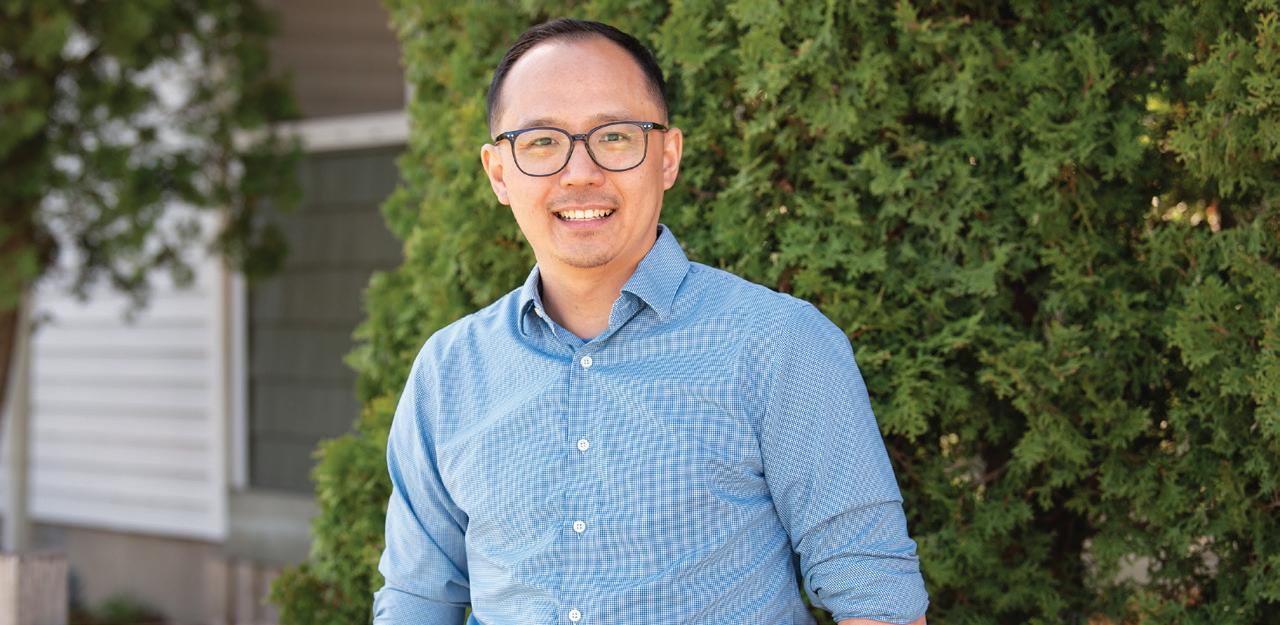

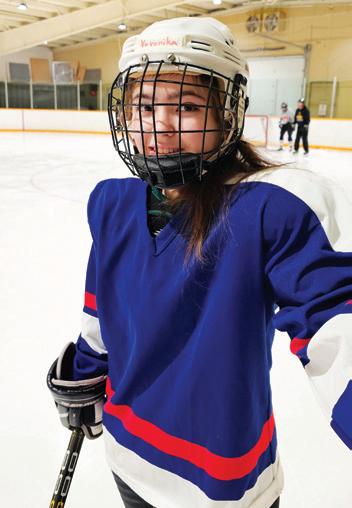

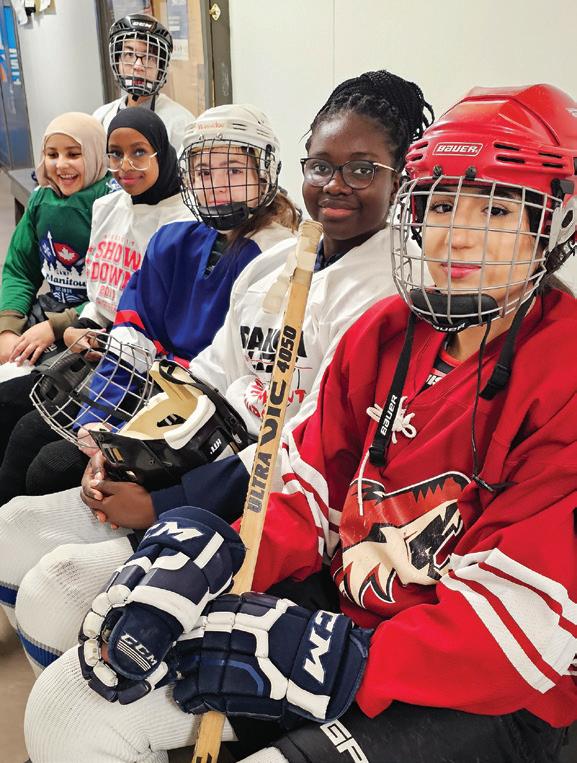
SPRING 2024 | THE MB TEACHER 41
BOOK REVIEWS
By the Equity and Social Justice Standing Committee

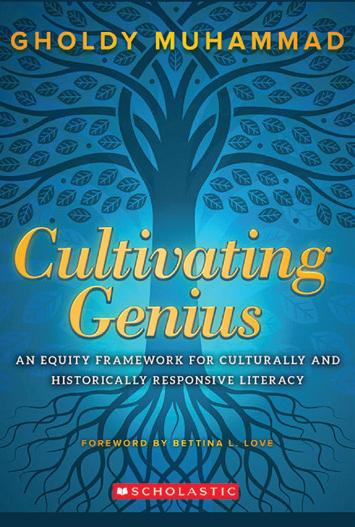
BRAIDING SWEETGRASS FOR YOUNG ADULTS: INDIGENOUS WISDOM, SCIENTIFIC KNOWLEDGE, AND THE TEACHINGS OF PLANTS
Author: Robin Wall Kimmerer | Adapted by: Monique Gray Smith
Publisher: Lerner Publishing Group (2022)
Braiding Sweetgrass for Young Adults is a beautiful culmination of medicines for healing and a call to honour the gifts of Mother Earth and the responsibility to give gifts to the earth in return.
Drawing from her experiences as an Indigenous scientist, Robin Wall Kimmerer, demonstrates how all living things—from strawberries and witch hazel to water lilies and lichen—provide us with gifts and lessons every day.
This new edition reinforces how wider ecological understanding stems from listening to the earth’s oldest teachers - the plants around us.
The Indigenous worldview is compellingly and vividly illustrated, in this new edition, through the guiding principles of the Honourable Harvest, which are as follows: never take the first, ask for permission, listen for the answer, take only what you need, minimize harm, use everything you take, share, be grateful, and reciprocate the gift.
This book offers thoughtful, provocative, and meaningful approaches to seeing the world we live in and our responsibility to taking care of Mother Earth so she can take care of us. It is a must read for educators in their professional, personal, and student learning journeys.
AN EQUITY FRAMEWORK FOR CULTURALLY AND HISTORICALLY RESPONSIVE LITERACY
Author: Gholdy Muhammad
Publisher: Scholastic (2020)
In Cultivating Genius, Dr. Gholdy Muhammad draws upon the traditions of 19th-century Black literacy societies, spaces in which literacy skills, nuanced discussion, culture, and genius thrived. From these traditions, Muhammad proposes the Historically Responsive Literacy Model, designed “by people of colour … for children of colour” (p. 11). The model invites teachers to plan “learning pursuits” with four goals: identity, skill, intellect, and criticality. Muhammad notes that addressing these four goals at the same time reflects the high standards members of Black literacy societies held for themselves. Four chapters include detailed examples and activities
for bringing the model to life. There are plenty of practices teachers can implement immediately, though the most meaningful work will begin once teachers rethink their units with Muhammad’s four goals in mind. In addition to suggestions for text set development and text selection, Muhammad provides thought-provoking questions for teachers, school leaders, and professional learning communities. The Historically Responsive Literacy Model can help teachers design rich learning experiences that align with Manitoba’s English Language Arts curriculum. In fact, Cultivating Genius might just be the guidebook literacy teachers need to transform their teaching practice.
42 THE MB TEACHER | SPRING 2024
SUMMER READING LIST
ESJ COMMITTEE’S TOP PICKS
21 THINGS YOU MAY NOT KNOW ABOUT THE INDIAN ACT
BY BOB JOSEPH
Bob Joseph delves into the complexities of The Indian Act, revealing hidden truths and historical injustices. This concise exploration sheds light on overlooked aspects, offering a crucial understanding of the Act’s impact on Indigenous communities.
POLICING BLACK LIVES: STATE VIOLENCE IN CANADA FROM SLAVERY TO THE PRESENT
BY ROBYN MAYNARD
Through meticulous research and personal narratives, Maynard reveals the enduring legacies of colonialism and slavery that have created the pervasive discrimination Black individuals face within the Canadian justice system and calls for urgent change towards racial justice and equity.
ELOQUENT RAGE: A BLACK FEMINIST DISCOVERS HER SUPERPOWER
BY BRITTNEY COOPER
A potent blend of memoir and manifesto, exploring the power of Black feminism. Through personal anecdotes and cultural analysis, Cooper celebrates the transformative potential of rage as a tool for empowerment and social change, advocating for justice and equality.
VALLEY OF A BIRDTAIL
BY DOUGLAS SANDERSON & ANDREW STOBO SNIDERMAN
A portrait of a community’s battle against environmental decline in Canada's
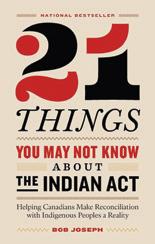
grasslands. Through vivid storytelling, “Valley of a Birdtail” highlights the community’s fight for survival and restoration, weaving themes of resilience, stewardship, and hope into a captivating narrative.
START HERE START NOW: A GUIDE TO ANTIBIAS AND ANTIRACIST WORK IN YOUR SCHOOL COMMUNITY
BY LIZ KLEINROCK
A practical roadmap for fostering an inclusive and antiracist school environment. Through insightful guidance and actionable steps, Kleinrock empowers educators to initiate meaningful conversations, challenge biases, and cultivate a culture of equity and belonging, laying the foundation for transformative change within their school community.
HOW TO HAVE DIFFICULT CONVERSATIONS ABOUT RACE
BY KWAME CHRISTIAN
Practical strategies for navigating challenging discussions on racial issues. Through empathy, active listening, and understanding, Christian guides readers to engage constructively, fostering mutual respect and learning. With insightful tips and real-life examples, this concise guide empowers individuals to initiate and sustain meaningful dialogues, promoting understanding and social change.
CHILDREN OF BLOOD AND BONE
BY TOMI ADEYEMI
Tomi Adeyemi weaves African mythology into the story of Zélie Adebola's journey to revive magic among her people. Alongside


her brother and a rebellious princess, Zélie confronts oppression and challenges a merciless monarchy to reclaim her cultural legacy.
FIREKEEPER’S DAUGHTER
BY ANGELINE BOULLEY
A coming-of-age tale in which Daunis, an Afro-Indigenous teen, confronts identity struggles amidst a deadly drug crisis. As she delves into a perilous investigation, she discovers resilience and hope, becoming a beacon for her people in this poignant exploration of community and identity.
IRON WIDOW
BY XIRAN JAY ZHAO
In a world where girls die piloting robots, Zetian seeks vengeance for her sister's death by becoming an Iron Widow. Paired with a powerful and controversial male pilot, she fights for survival and aims to unravel the system's misogyny.
BLACK CAKE
BY CHARMAINE WILKERSON
Secrets buried in a family recipe resurface, unraveling generations of love, betrayal, and identity. As siblings confront their shared past, their mother’s enigmatic history unfolds, revealing the bittersweet truth about sacrifice and resilience. A poignant tale of heritage and the power of familial bonds.
YELLOWFACE
BY R.F. KUONG
A look into the complexities of racial identity through the lens of a ChineseAmerican actor confronting stereotypes in Hollywood. Struggling against prejudice and cultural appropriation, he navigates his career while questioning his own authenticity.
SPRING 2024 | THE MB TEACHER 43
Pass the Mic: Let’s talk about racism
Designed for educators, our free video series, teacher guide and onsite/virtual field trips offer tools to talk about racism, bias, micro aggressions, intersectionality and acceptance, as well as allyship. Our resources are available in both official languages.
Help create a safe space for all; scan the code to learn how:





#AtCMHR














































































